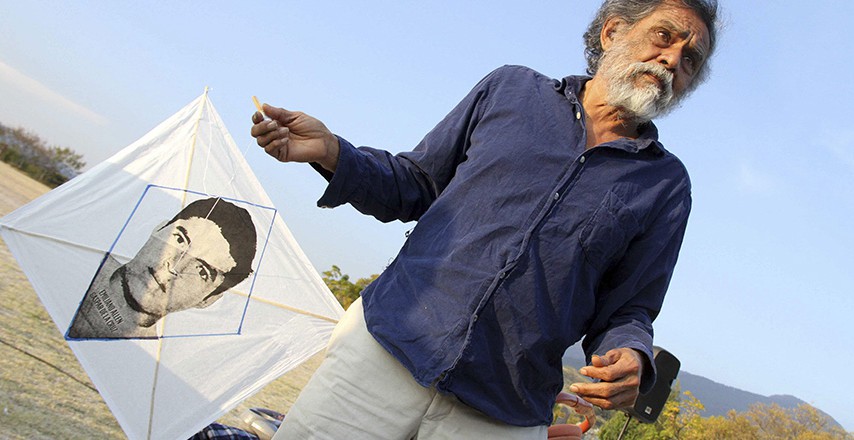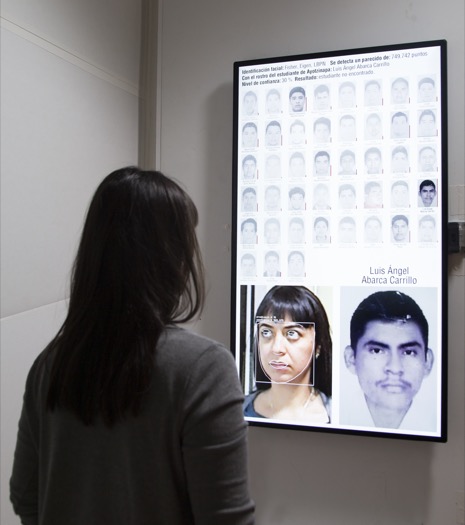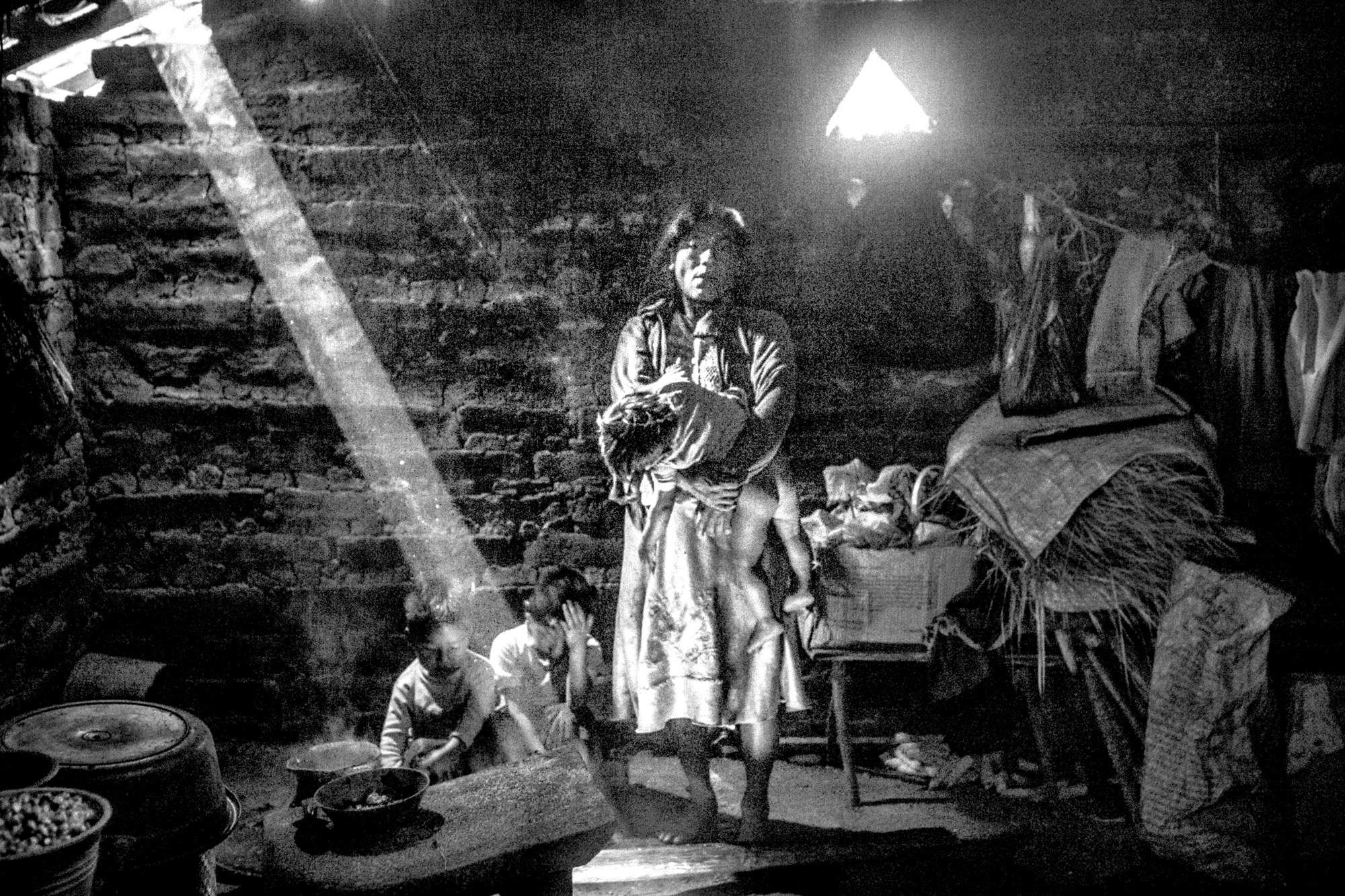Category: Exhibición | Exhibitions
EL FIN DEL GRAN RELATO
El fin del Gran Relato Curaduría: Henry Eric Hernández Exhibición: 27 de enero, 5 de mayo, 2018 (Puerto Vallarta, Enero 2018) La Oficina de Proyectos Culturales tiene el honor de presentar la exhibición de arte contemporáneo”El Fin del Gran Relato”, que investiga cómo se define Cuba en 2018 desde dentro y hacia fuera del país. ¿Hay una nueva apertura o… Read more →
DeLIMITations: Mapeo de la frontera de 1821 entre México y Estados Unidos
DeLIMITations: Mapeo de la frontera de 1821 entre México y los Estados Unidos
Marcos Ramírez ERRE y David Taylor
Exhibición: 7 de octubre, 2017 a 13 de enero, 2018
OPC junto con el Instituto Vallartense de Cultura presentan la exposición DeLIMITations: Mapeo de la frontera de 1821 entre México y los Estados Unidos, una instalación de sitio-especifico de los artistas Marcos Ramírez ERRE y David Taylor.
DeLIMITations es una instalación de 3800 kilómetros de largo invocando expediciones de exploración y conquista del siglo XIX, los dos artistas se dispusieron a trazar la frontera entre México y los Estados Unidos tal como existía en 1821. Esta frontera nunca fue examinada y el registro de su breve historia de veintisiete años sólo existe en forma de documentos de tratados y mapas antiguos. El objetivo del proyecto era marcar periódicamente el límite histórico con una serie de monumentos que imitan los marcadores instalados a lo largo de la frontera contemporánea entre México y los Estados Unidos.

En julio de 2014, instalaron con éxito 47 obeliscos en un vasto paisaje que abarca los 2,1 millones de kilómetros cuadrados de territorio cedidos a los Estados Unidos en el Tratado de Guadalupe Hidalgo tras la Guerra entre México y los Estados Unidos (1846–1848). El primer monumento fue colocado en la costa del Pacífico cerca de Brookings, Oregon, y el último en la desembocadura del río Sabina, cerca de Port Arthur, Texas. Las ciudades y pueblos a lo largo de la frontera histórica incluyen a Brookings, OR; New Pine Creek, CA; Denio, NV; McDermitt, NV; Jackpot, NV; Medicine Bow, WY; Leadville, CO; Cañon City, CO; Pueblo, CO; La Junta, CO; Syracuse, KS; Garden City, KS; Dodge City, KS; Texarkana, TX; Orange, TX; y Port Arthur, TX. Todas estas ciudades y pueblos hubieran sido fronterizos de haber permanecido esa frontera como tal.

La obra de Ramírez y Taylor cuestiona la inmutabilidad y permanencia de las fronteras en un momento en que las reivindicaciones territoriales se disputan en todo el mundo. Al hacer visibles el borde original, reconocen el territorio que México perdió y reclaman por el presente. No necesariamente impugnan la frontera actual, pero insisten en el reconocimiento de que Estados Unidos y México tienen una historia compleja y compartida y un interés común.
Los monumentos colocados lo largo de la frontera de 1821 permanecerán por un tiempo indeterminado, aunque sin duda serán desplazados y la línea marcada se desvanecerá.
El proyecto fue comisionado como parte de la exposición Unsettled Landscapes de laBiennial SITE Santa Fe, Delimitations recibió un generoso apoyo de las siguientes instituciones e individuos: El Centro de Arte y Medio Ambiente del Museo de Arte de Nevada; Charles y Anne Bannon Horak; Fundación Codet; Instituto de Investigaciones Culturales – Museo UABC, Museo de Arte Contemporáneo San Diego California, James Robbins, Erica Torri y la Universidad de Arizona.

La Oficina de Proyectos Culturales (OPC) se enorgullece de estar coordinando la itinerancia de la exposición DeLIMITations que será recibida en febrero por el Museo de las Artes Universidad de Guadalajara (MUSA) y en abril por el Museo Regional de Historia de Colima.
Marcos Ramírez ERRE. Nacido en Tijuana en 1961, obtiene la Licenciatura en Derecho en la Universidad Autónoma de Baja California en 1982. En 1983 emigra a los Estados Unidos donde trabaja en la industria de la construcción durante 17 años. En 1989 – aún manteniendo su actividad como constructor – empieza su incursión en el campo de las Artes Visuales. Ha participado en residencias, conferencias y muestras de arte en países como México, Canadá, Estados Unidos, Alemania, Suecia, Polonia, Portugal, Francia, España, Cuba, Colombia, Puerto Rico, Chile, Brasil, Argentina, Rusia y China. Algunas de estas exhibiciones de carácter internacional tales como Insite 94, Insite 97, la Sexta y Séptima Bienales de la Habana, la Bienal del Museo Whitney del año 2000, la Trienal Poligráfica de San Juan Puerto Rico y el Caribe, la Bienal de Sao Paulo – Valencia, la Segunda Bienal de Moscú, la Bienal de California y La Bienal Zero One de Silicon Valley. Así como Made in California, México Iluminado, Extrange New World, From Baja to Vancouver, Política de la Diferencia / Arte Ibero Americano de fin de siglo, y ECO. Arte Contemporáneo Mexicano en el Centro de Arte Museo Reina Sofía y Crisisss Arte y confrontación ,América Latina, en el Palacio de Bellas Artes de México entre otras. Ha impartido cursos en la Escuela de Arte de la Universidad de California en San Diego y en el California Institute of the Arts, en Valencia California.En 2007 recibió la beca United States Artist Fellowship, y desde el 2009 es miembro del Sistema Nacional de Creadores de Arte. Del 2003 al 2010 fundó Estación Tijuana, espacio alternativo donde desarrolló un programa sobre Arte, Arquitectura, Urbanismo y Cultura Popular. En el 2011 presentó una exhibición retrospectiva de 20 años de trabajo titulada La Reconstrucción de los Hechos en el Museo Carrillo Gil de la Ciudad de México.
David Taylor. Las fotografías, instalaciones multimedia y libros de artista de David Taylor han sido expuestos en exposiciones colectivas e individuales en lugares como el Museo de Fotografía Contemporánea del Columbia College, el Museo de Arte Contemporáneo Aldrich, el Museo de Arte de Nuevo México y el Museo de Arte de El Paso, Tx. El trabajo de Taylor está en las colecciones permanentes de: Fidelity Investments, el Museo de Bellas Artes, Houston, Tx., el Museo de Fotografía Contemporánea y el Palacio de los Gobernadores / Museo de Historia de Nuevo México, entre otros. El New Yorker blog, New York Times, Los Angeles Times, la revista Orion, PREFIX PHOTO, Fraction Magazine y la edición de México / América Latina de la revista Esquire han presentado sus imágenes. El examen continuo de Taylor de la frontera de los Estados Unidos/ México fue apoyado por una beca de la John Simon Guggenheim Memorial Foundation en el 2008. Su monografía “Working the Line” fue publicada por Radius Books en el 2010 y ha recibido numerosos reconocimientos como “mejor libro” además de premios de excelencia en diseño.
DeLIMITations: Mapping the border of 1821 between Mexico and the United States
Marcos Ramírez ERRE and David Taylor
Exhibition: October 7, 2017 to January 13, 2018
OPC, in collaboration with the Instituto Vallartense de Cultura,are honored to present DeLIMITations: Mapping the border of 1821 between Mexico and the United States, a site-specific installation by artists Marcos Ramírez ERRE and David Taylor.
DeLIMITations is a 2,400 mile long installation invoking nineteenth-century exploration and conquest expeditions. In 2014, artists Marcos Ramírez ERRE and David Taylor set out to trace the historical 1821 border between Mexico and the western territories of the United States. That border stretched from the present-day Oregon/California state line to the Gulf of Mexico just west of Louisiana, and had previously only existed as a reference on historic maps and treaty documents because it had never been surveyed or physically marked.

For DeLIMITations, ERRE and Taylor asked the question, “What would Mexico and the United States look like if that boundary had been fully realized?” ERRE and Taylor, accompanied by filmmaker José Inerzia, who helped document the process, drove a van outfitted to serve as a mobile command center, fabrication space, and camper along the 1821 border. The artists successfully installed 47 obelisks in a vast landscape that encompasses the 2.1 million square kilometers of land ceded to the United States in the Treaty of Guadalupe Hidalgo after the War between Mexico and the United States (1846-1848).
The first monument was placed on the Pacific coast near Brookings, Oregon, and the last at the mouth of the Sabina River, near Port Arthur, Texas. Cities and towns along the historic border include Brookings, OR; New Pine Creek, CA; Denio, NV; McDermitt, NV; Jackpot, NV; Medicine Bow, WY; Leadville, CO; Cañon City, CO; Pueblo, CO; The Board, CO; Syracuse, KS; Garden City, KS; Dodge City, KS; Texarkana, TX; Orange, TX; and Port Arthur, TX. All these cities and towns would have been frontier had the border remained as such.

The work of Ramírez and Taylor questions the immutability and permanence of the borders at a time when territorial entitlements are disputed around the world. By making the original border visible, they recognize the territory that Mexico lost and claim for the present. They do not necessarily challenge the current border, but insist on the recognition that the United States and Mexico have a complex and shared history and a common interest.
The monuments placed along the border of 1821 will remain for an indeterminate time, although they will undoubtedly be displaced and the marked line will vanish.
The project was commissioned as part of the Unsettled Landscapes exhibition of the Santa Fe Biennial SITE. Delimitations received generous support from the following institutions and individuals: The Art and Environment Center of the Nevada Museum of Art; Charles and Anne Bannon Horak; Codet Foundation; Institute of Cultural Research – UABC Museum, Art Museum Contemporary San Diego, California, James Robbins, Erica Torri and the University of Arizona.

The Office for Cultural Proyects (OPC) is proud to be coordinating the itinerary of the DeLIMITations exhibition as it will be traveling to the Museum of the Arts of the University of Guadalajara (MUSA) in February and to the Regional Museum of History of Colima in April.
Marcos Ramírez ERRE. Born in Tijuana in 1961, he obtained a Law Degree from the Autonomous University of Baja California in 1982. In 1983 he moved to the United States where he worked in the construction industry for 17 years. In 1989 –while maintaining his activity as a builder – he began his foray into the field of Visual Arts. He has participated in residencies, conferences and art exhibitions in countries such as Mexico, Canada, United States, Germany, Sweden, Poland, Portugal, France, Spain, Cuba, Colombia, Puerto Rico, Chile, Brazil, Argentina, Russia and China. Some of these international exhibitions such as Insite 94, Insite 97, the Sixth and Seventh Biennials of Havana, the 2000 Whitney Museum Biennial, the San Juan Puerto Rico and Caribbean Polygraphic Triennial, the Sao Paulo Biennial -Valencia, the Second Moscow Biennial, the California Biennial and the Zero One Biennial of Silicon Valley. As well as Made in California, Illuminated Mexico, Extrange New World, From Baja to Vancouver, Politics of Difference / Ibero-American Art at the end of the century, and ECO. Contemporary Mexican Art at the Reina Sofía and Crisisss Art Center Art and confrontation, Latin America, at the Palace of Fine Arts of Mexico among others. He has taught at the School of Art of the University of California at San Diego and at the California Institute of the Arts in Valencia California. He received the United States Artist Fellowship in 2007 and since 2009 is a member of the National Creator System of Art. From 2003 to 2010 he founded Estación Tijuana (Tijuana Station), an alternative space where he developed a program on Art, Architecture, Urbanism and Popular Culture. In 2011 he presented a retrospective exhibition of 20 years of work entitled The Reconstruction of the Facts at the Carrillo Gil Museum in Mexico City.
David Taylor. Taylor’s photographs, multimedia facilities and artist’s books have been exhibited at individual and group exhibitions at places such as Columbia College Contemporary Photography Museum, Aldrich Museum of Contemporary Art, New Mexico Museum of Art, and Museum of Contemporary Art. Art of El Paso, Tx. Taylor’s work is in the permanent collections of Fidelity Investments, the Museum of Fine Arts, Houston, Tx., The Museum of Contemporary Photography and the Palace of Governors / Museum of History of New Mexico, among others. The New Yorker blog, New York Times, Los Angeles Times, Orion magazine, PREFIX PHOTO, Fraction Magazine and the Mexico / Latin America issue of Esquire magazine have presented their images. Taylor’s continued examination of the United States / Mexico border was supported by a grant from the John Simon Guggenheim Memorial Foundation in 2008. His monograph “Working the Line” was published by Radius Books in 2010 and has received numerous awards as “best book” as well as awards for excellence in design.
Usted está aquí: Dicotomías del paisaje
Usted Está Aquí:
Dicotomías del Paisaje
Curaduría: Oscar Morán
Exhibición: 27 de mayo al 26 de agosto, 2017
—3° Aniversario de OPC—
(Puerto Vallarta, Jal.) La exhibición Usted está aquí: Dicotomías del paisaje se desarrollará del 27 mayo al 26 agosto de 2017. El ciclo de curadurías “Usted está aquí” de Oscar Morán Guillén continúa la reflexión del espacio urbano iniciada con la muestra del año pasado, Usted está aquí: Aproximaciones Urbanas. En esta edición se busca evidenciar la vulnerabilidad del paisaje natural, la tensión entre naturaleza y urbe, así como la necesidad de un discurso crítico en torno a la planeación y gestión territorial no-urbana.
La exposición pretende propiciar un diálogo sobre el concepto de patrimonio paisajístico, su relevancia en el imaginario colectivo y en el sentido de pertenencia comunitaria, así como su impacto en la calidad de vida. La muestra será de corte multidisciplinario y participarán 18 creadores, quienes producirán obras específicas para la exposición así como intervenciones en espacios públicos.
Participantes: Álvaro Argüelles, Alfonso Baños, Sinclair Castro, Arturo Dávila, Luis Echeverría, Fallen Fruit, Luis Galeano, Cecilia Hurtado, Franca Mata, Arturo Montero, Jorge Morales, Gerardo Moran, Jimena Odetti, Fanny Olivares, Javiera Pintocanales, Jorge Ramírez, Alberto Reyes, Juan Soler.
La muestra del año pasado dio cuenta de las cualidades de diversos aspectos urbano-arquitectónicos en locaciones de la ciudad y permitió abrir la reflexión en torno al espacio urbano de Puerto Vallarta, más allá de las narrativas estereotipadas del turismo. Con Usted está aquí: Dicotomías del paisaje, la reflexión alcanza una mayor complejidad al proyectar intervenciones en la ciudad que funcionan como micro-investigaciones en torno a la transformación del paisaje y con ello, a la transformación de las relaciones sociales que pueden establecerse entre los habitantes de la ciudad.
OPC organiza una exposición al año dedicada a Puerto Vallarta con motivo de su aniversario (tanto de la galería como del Puerto). En este caso Usted está aquí: Dicotomías del paisaje coincide con el 99º aniversario de Puerto Vallarta abriendo un espacio que propicia la discusión y el diálogo acerca del valor del paisaje, la necesidad de un discurso territorial y las consecuencias de la masificación en entornos de gran valor natural y paisajístico.
Usted está aquí: Dicotomías del paisaje es posible gracias al Instituto Vallartense de Cultura y al apoyo de Proyecta Producción 2017 otorgado por la Secretaría de Cultura de Jalisco.
Coincidente con la apertura de la exposición, OPC amplía su área de operaciones al inaugurar un espacio anexo a la garería que cumplirá las funciones de taller y centro de documentación. El espacio llevará el nombre de Taller OPC y abrirá sus puertas el 27 de mayo de 2017. Albergará una colección bibliográfica única en la ciudad especializada en arte contemporáneo, arquitectura y letras, gracias a donativos de materiales diversos, entre los que destacan una colección de libros de poesía de la poeta Carmen Villoro (premio Jalisco 2016), ediciones de la Revista Luvina de Guadalajara, volúmenes de la micro-biblioteca de CC-Catálogo, proyectos de Buró-Buró, una colección de Mantis Editores, una selección de libros de literatura y libros de Perceval Press y Smart Art Press. Taller OPC será posible gracias al generoso apoyo de la familia Barlow y William Hobi.
La apertura de Taller OPC permitirá ofrecer un rango más amplio de servicios culturales y educativos al público en general. El espacio tendrá una vocación multi-funcional para talleres, lectura, conferencias, y exposiciones de estudiantes y talleristas. También servirá como un centro para talleres de verano para niños y jóvenes locales.
Oscar Moran Guillén es arquitecto por el ITESO y urbanista por la Universidad del Sur de California. Es fundador del estudio de Arquitectura y Urbanismo RH+OM. Cuenta con más de 15 años de experiencia en el ramo en México y Estados Unidos. Reside en Puerto Vallarta desde 2012 y es miembro del equipo fundador de OPC.
You Are Here:
Dichotomies of Landscape
Curator: Oscar Morán
Exhibition: May 27 to August 26, 2017
—3rd Anniversary of OPC—
(Puerto Vallarta, Jal.) The exhibition You Are Here: Dichotomies of landscape will take place from May 27 to August 26, 2017. The exhibition series, “You Are Here” curated by Oscar Morán Guillén continues the dialogue about urbanism and landscape that began with last year´s exhibition You Are Here: Urban Approximations. In this edition, the show seeks to highlight the vulnerability of the natural landscape, the tension between natural territory and urban development, and the lack of critical dialogue around non-urban planning and territorial management.
The exhibition aims to foster a conversation around the concept of landscape heritage, its relevance both in the collective imaginary and in the sense of community belonging, as well as its impact on the quality of life. The exhibition will be multidisciplinary and will include work by 17 creators who will be producing specific works for the exhibition, as well as interventions in public spaces.
Participants: Álvaro Argüelles, Alfonso Baños, Sinclair Castro, Arturo Dávila, Luis Echeverría, Fallen Fruit, Luis Galeano, Cecilia Hurtado, Franca Mata, Arturo Montero, Jorge Morales, Gerardo Moran, Jimena Odetti, Fanny Olivares, Javiera Pintocanales, Jorge Ramírez, Alberto Reyes, Juan Soler.
Last years exhibition revealed the qualities of various urban-architectural aspects in city locations and opened the way for reflection on the urban space of Puerto Vallarta, beyond the stereotyped narratives of tourism. With You are here: Dichotomies of the landscape, the reflection reaches a greater complexity when projecting interventions in the city that function as micro-investigations around the transformation of the landscape and with that, to the transformation of the social relations that can be established between the people of the city.
OPC organizes an annual exhibition dedicated to Puerto Vallarta on the occasion of its anniversary (both the gallery and the city). In this case You are here: Dichotomies of the landscape coincides with the 99th anniversary of Puerto Vallarta, opening a space that encourages discussion and dialogue about the value of the landscape, the need for a territorial discourse and the consequences of the massification in environments of great natural and scenic value.
You are here: Dichotomies of the landscape is possible thanks to the Instituto Vallartense de Cultura and the generous support of Proyecta Producción 2017 given by the Secretaría de Cultura Jalisco.
Coinciding with the opening of the exhibition, OPC expands its area of operations by inaugurating a space adjacent to the gallery that will fulfill the functions of workshop and documentation center. The space will be called OPC Workshop and will open its doors on May 27, 2017. It will house a unique bibliographic collection in the city specializing in contemporary art, architecture and letters, thanks to donations of diverse materials, among which a stand out collection of poetry books from Carmen Villoro (Jalisco 2016 prize), editions of Luvina Magazine of Guadalajara, volumes of the CC-Catalog micro-library, Buró-Buró projects, a collection of Mantis Editores, a selection of literature books and books by Perceval Press and Smart Art Press. OPC Workshop will be possible thanks to the generous support of the Barlow family and William Hobi.
The opening of OPC Workshop will allow to offer a wider range of cultural and educational services to the general public. The space will have a multi-functional vocation for workshops, reading, conferences, and student exhibitions. It will also serve as a center for summer workshops for local children and youth.
Oscar Moran Guillén is an arquitect by ITESO and urban planner by the University of South California. He is founder of RH+OH Arquitecture and Design Studio. He has more than 15 years of experience in the field in Mexico and the United States. He has been living in Puerto Vallarta since 2012 and is a founding team member of OPC.
Fisuras en el Trópico
Fisuras en el Trópico:
Prácticas artísticas de los 90s en el occidente
Curaduría: Rubén Méndez
Exhibición: 4 de Febrero, 2016 al 6 de Mayo, 2017
Oficina de Proyectos Culturales tiene el honor de presentar la siguiente exhibición de arte contemporáneo Fisuras en el trópico: Prácticas artísticas de los 90s en el occidente con curaduría de Rubén Méndez.
Fisuras en el trópico tiene como objetivo mostrar el modelo de producción que se llevó a cabo por un grupo de artistas en la década de los 90s en el occidente del país y de las iniciativas culturales que permitieron su desarrollo. La exhibición pretende dar cuenta de esta producción pero también se realizará un mapa que conectará eventos, lugares y personajes que fueron actores de primer orden en el desarrollo cultural de ese momento.
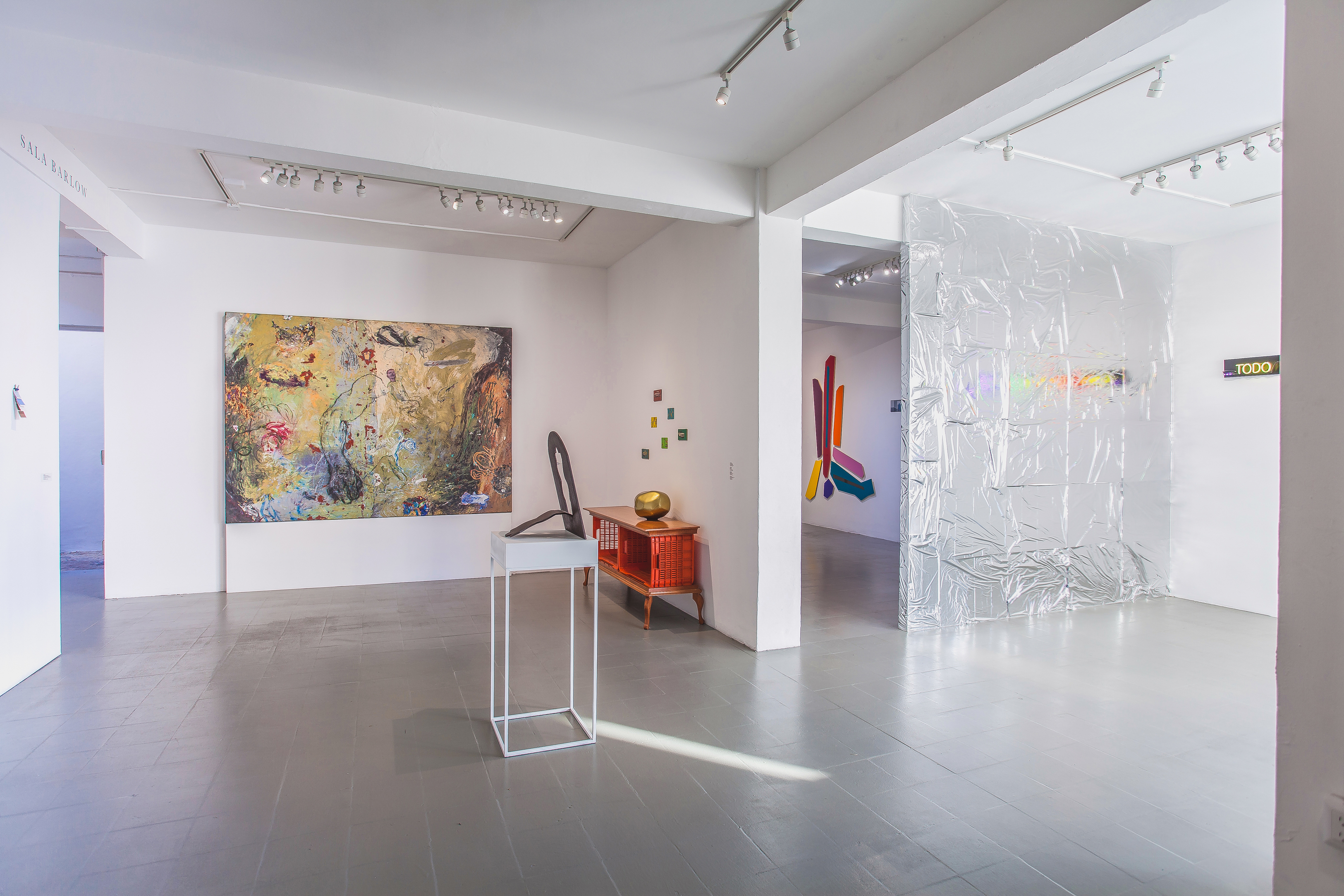
El grupo de artistas seleccionados son: Davis Birks, Eduardo Cervantes, Jose Dávila, , Mónica Escutia, Gil Garea, Omar Guerra, Gonzalo Lebrija, Jorge Méndez Blake, Diego Medina, Lourdes Méndez, Rubén Méndez, Daniel Navarro, Paul Nevin, Fernando Palomar, Alejandro Ramirez, Ernesto Ramirez Ramirez, Claudia Rodríguez, Guillermo Santamarina, Agustín Solorzano, Luis Miguel Suro, Francisco Ugarte
Con esta exposición y las mesas de dialogo se pretende brindar al público general interesado en el arte contemporáneo, información que amplíe su comprensión de lo acontecido en una década clave para el desarrollo del arte en nuestro país. Los elementos de investigación los enmarcamos en el territorio occidente; espacio geográfico que ha sido origen de personajes y acontecimientos de grandes alcances pero con muy poca difusión y registro testimonial.
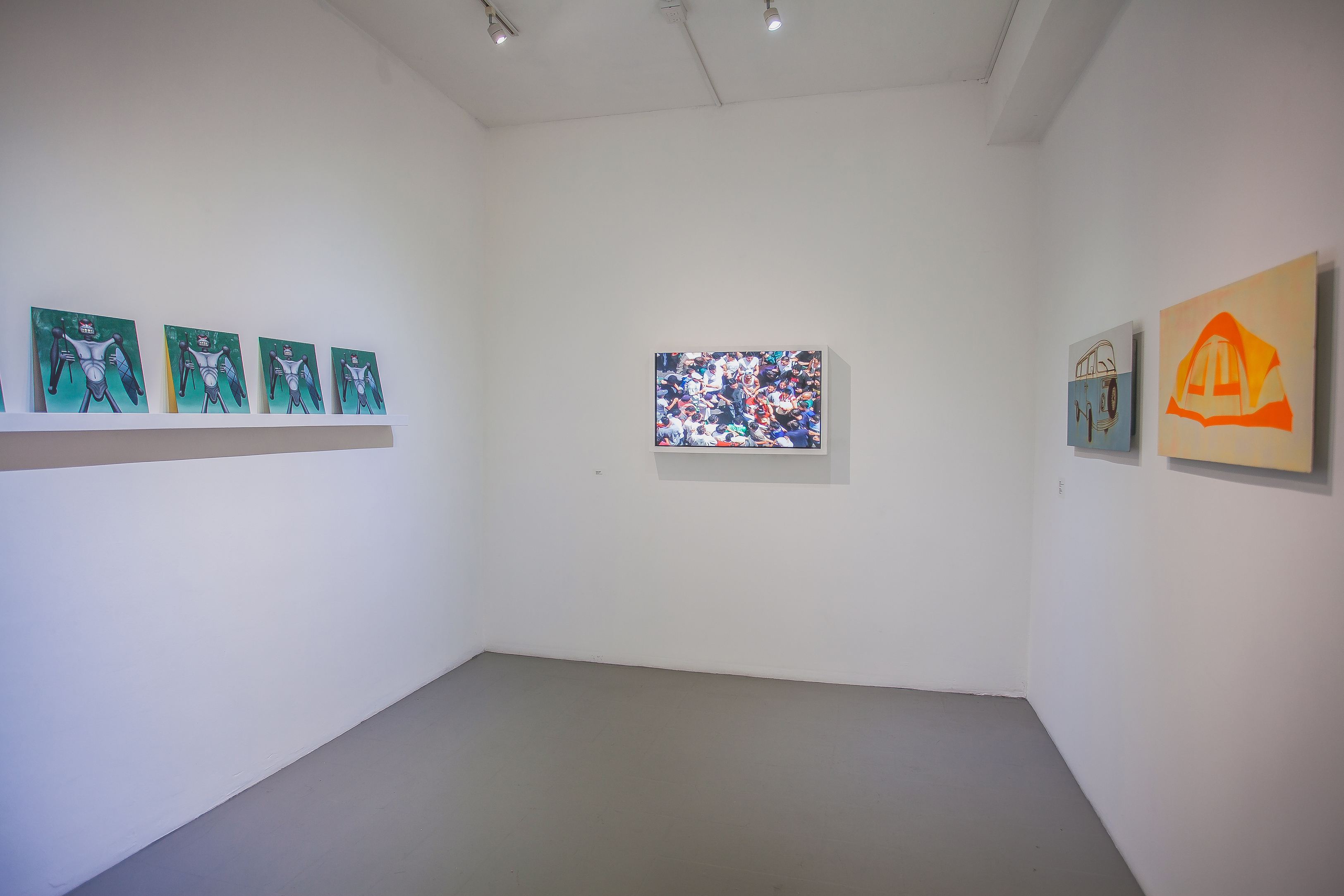
Las circunstancias en el occidente del país se muestran más amables en la actualidad, esto es el resultado de una serie de elementos que se conjugaron en el pasado. Fisuras en el trópico no intenta responder la pregunta ¿Cómo llegamos aquí? Es una exhibición que da fe del entorno que conformó el espíritu de una época en una zona específica del país, esto a través de sus resultados artísticos. El cambio de paradigma, la reflexión teórica, la crisis económica, social y política, el cambio de milenio, fueron factores –entre otros- que se conjugaron para que la fisura se ahondara. También esta exhibición es una revisión documental de proyectos que hicieron para que estos cambios sucedieran; Expo-arte, -primer feria de arte contemporáneo en el país, El Foro Internacional de Arte Contemporáneo (FITAC), los proyectos independientes NAP y El callo, los talleres de producción artística en Guadalajara; Cerámica Suro y taller mexicano de gobelinos (TMG), los curadores que dieron orden y estructura con sus propuestas, los coleccionistas que animaron un incipiente mercado. Así una serie de acciones, personajes y lugares que fueron parte activa de ese momento, proyectos que se enumerarán en una gráfica dentro de la exhibición.
El criterio para la selección de los artistas se basa en su participación activa en la época que refiere la exhibición. Las obras no necesariamente corresponden en temporalidad ya que la selección está sujeta a cuestiones de espacio y representación de otros actores indirectos como lo son los talleres de producción.
Dentro de las actividades paralelas de la exposición se llevaran a cabo charlas y mesas redondas con el curador e invitados aún por definir. También se integrará una mesa en la que el público podrá consultar libros y documentos de la época con lo que podrá ampliar su perspectiva sobre el tema.
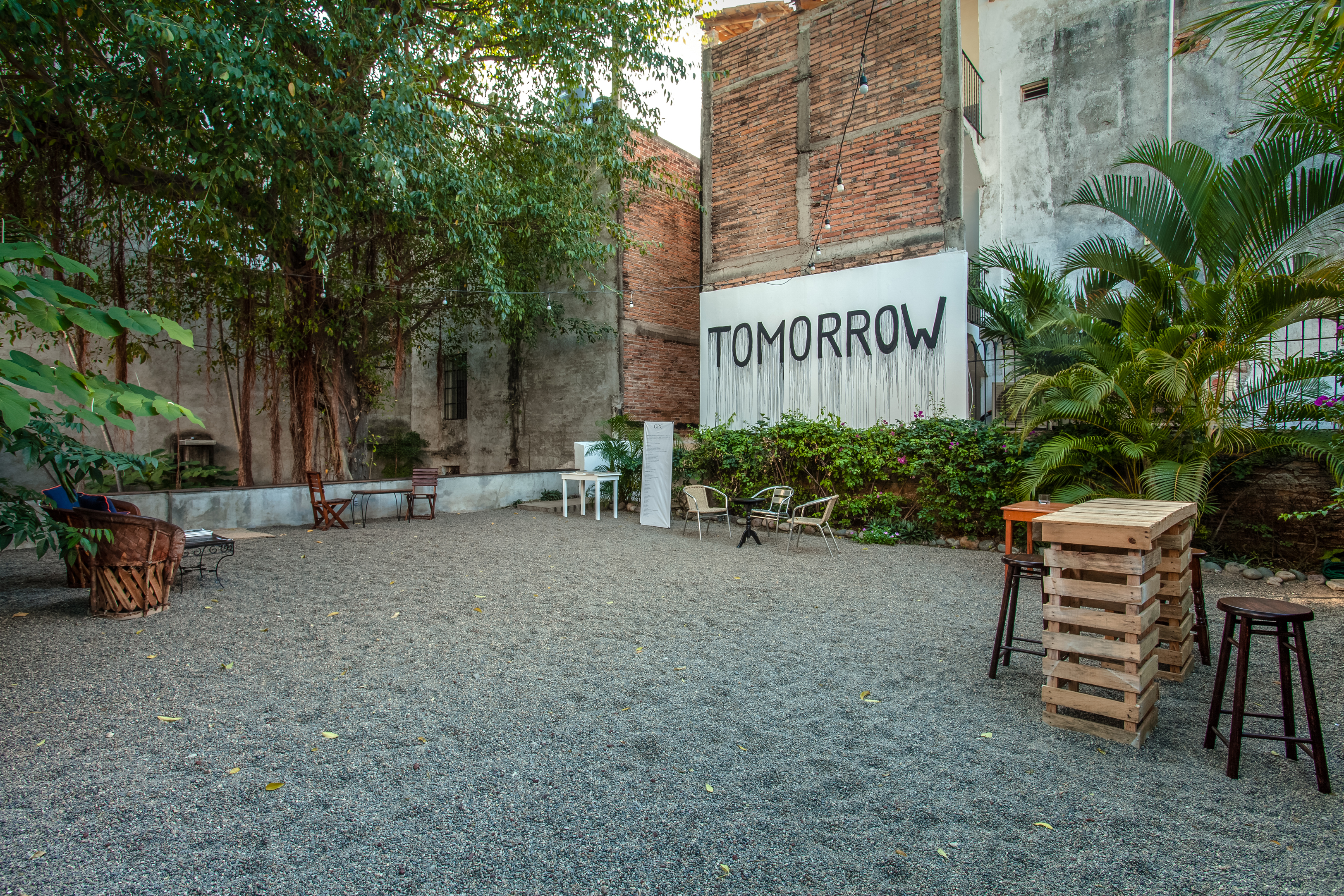
RUBÉN MÉNDEZ (Guadalajara, 1960)Vive y trabaja en Guadalajara.
Es artista, curador y museógrafo, Desde 1988 a la fecha ha desarrollado varios proyectos curatoriales y ha desarrollado diseños museográficos en diversos espacios como Museo MARCO de Monterrey, Museo de Arte Moderno y Palacio de Bellas Artes en la Ciudad de México; Instituto Cultural Cabañas, Casa Taller José Clemente Orozco, Casa ITESO Clavijero, Central de Arte de Guadalajara y La Planta Arte Contemporáneo, en Guadalajara. En 1994-95 trabajo para FARCO y el Foro Internacional de Arte Contemporáneo. Es miembro fundador del despacho CUMULO (Curaduría, Museografía y Logística) al lado de Carlos Ashida; de los colectivos CACA (Colectivo de Acción y Creación Artística), LIPO (La Irreversible Producción Ordinaria), y de los proyectos independientes Clemente Jacqs Laboratorio y Colegio Aires de Occidente–en colaboración con Mariana Munguía, Cristina Sesscose, y Eduardo Sarabia, entre otros-. Fue director de curaduría en el Museo de las Artes y Director de programación de la Galería del Tren Eléctrico Urbano. Actualmente es miembro de la comisión de planeación del PECDA, S.C. de Jalisco y director de Museografía y Curaduría del Instituto Cultural Cabañas.
Fisuras en el trópico será posible gracias al generoso apoyo de William Hobi.
Agradecemos a nuestros patrocinadores: PAC Patronato de Arte Contemporáneo; Secretaria de Cultura, Jalisco; Instituto Vallartense de Cultura; Mero Mero Mezcal ; El Terrible Cerveza; El Patio de Mi Casa, y Hotel Villa Mercedes.
Fissures in the Tropics
Artistic Practices of the 90s in the West
Curator: Rubén Méndez
Exhibition: February 4, 2016 to May 6, 2017
The Office of Cultural Projects has the honor to present the following exhibition of contemporary art Fissures in the Tropics: Artistic Practices of the 90s in the West curated by Rubén Méndez. Fissures in the Tropics aims to show the production model that was carried out by a group of artists in the 90s in the west of the country and the cultural initiatives that allowed its development. The exhibition aims to give an account of this production but also a map will be made that will connect events, places and characters that were actors of the first order in the cultural development of that moment.
The group of selected artists are: Davis Birks, Eduardo Cervantes, Jose Dávila, Mónica Escutia, Gil Garea, Omar Guerra, Gonzalo Lebrija, Jorge Méndez Blake, Diego Medina, Lourdes Méndez, Rubén Méndez, Daniel Navarro, Paul Nevin, Fernando Palomar, Alejandro Ramirez, Ernesto Ramirez Ramirez, Claudia Rodríguez, Guillermo Santamarina, Agustín Solorzano, Luis Miguel Suro, Francisco Ugarte.

With this exhibition and the round tables discussions, it is intended to provide the general public interested in contemporary art, information that extends their understanding of what happened in a key decade for the development of art in our country. The research elements are framed in the western territory; geographical space that has been the origin of characters and events of great scope but with very little diffusion and testimonial record.
The circumstances in the occident of the country are more friendly today, this is the result of a series of elements that were combined in the past. Fissures in the tropics does not try to answer the question “How did we get here?”. It is an exhibition that testifies to the environment that shaped the spirit of an era in a specific area of the country through its artistic results. The paradigm shift, the theoretical reflection, the economic, social and political crisis, the change of millennium, were factors – among others – that combined so that the fissure deepened. Also, this exhibition is a documentary revision of projects that made for these changes to happen; Expo-arte, the first contemporary art fair in the country, the International Forum of Contemporary Art (FITAC), the independent projects NAP and El callo, workshops of artistic production in Guadalajara; Cerámica Suro and the Mexican gobelinos workshop (TMG), the curators who gave order and structure with their proposals, the collectors who encouraged an incipient market. Thus a series of actions, characters and places that were active part of that moment, projects that will be listed in a graph within the exhibition.

The criterion for the selection of artists is based on their active participation in the era of the exhibition refers to. The works do not necessarily correspond in temporality since the selection is subject to matters of space and representation of other indirect actors such as the production workshops.
Within the parallel activities of the exhibition, talks and round table discussions will be held with the curator and guests yet to be defined. A table with books and documents of the time will also be available for the public to consult and extend their perspective on the subject.

RUBÉN MÉNDEZ (Guadalajara, 1960) Lives and works in Guadalajara.
He is an artist, curator, and museographer. From 1988 to the present he has developed several curatorial projects and has developed museographic designs in diverse spaces such as MARCO Museum of Monterrey, Museum of Modern Art and Palace of Fine Arts in Mexico City; Instituto Cultural Cabañas, Casa Taller José Clemente Orozco, Casa Clavijero ITESO, Guadalajara Art Center and The Contemporary Art Plant, in Guadalajara. In 1994-95 he worked for FARCO and the International Forum of Contemporary Art. He is a founding member of the firm CUMULO (Curatorship, Museography and Logistics) next to Carlos Ashida; of the collective CACA (Collective of Action and Artistic Creation), LIPO (the Irreversible Ordinary Production), and independent projects Clemente Jacqs Laboratory and Colegio Aires de Occidente – in collaboration with Mariana Munguía, Cristina Sesscose, and Eduardo Sarabia, among others -. He was director of curatorship at the Museum of Arts and Programming Director of the Urban Electric Train Gallery. He is currently a member of the planning committee of PECDA, S.C. of Jalisco and Director of Museography and Curatorship of the Cabañas Cultural Institute.
Fissures in the tropics will be possible thanks to the generous support of William Hobi.
We thank our sponsors: PAC Patronage of Contemporary Art; Secretary of Culture, Jalisco; Vallartense Institute of Culture; Mero Mero Mezcal; Cerveza El Terrible Beer; El Patio de Mi Casa, and Hotel Villa Mercedes.
Del acstracto ranchero al naquismo mágico
Del acstracto ranchero al naquismo mágico
Obra de Gil Garea
Curaduría: Carmen Villoro
Exhibición: 8 de Octubre, 2016 a 7 de enero, 2017
OPC junto a la Secretaría de Cultura de Jalisco (SC), el Ex Convento de Carmen, y el Instituto Vallartense de Cultura presentan la exposición “Del acstracto ranchero al naquismo mágico” del artista Gil Garea, y curarda por Carmen Villoro.
Es una exposición que incluye instalaciones, pintura y obra gráfica del artista Gil Garea. Su obra contiene temática tan extensa como el paisaje rural, el marino, escenarios urbanos, objetos de uso cotidiano, naturaleza muerta, fiesta taurina, futbol, insectos, retratos, ornitorrincos, juguetes, íconos populares y figuras religiosas.
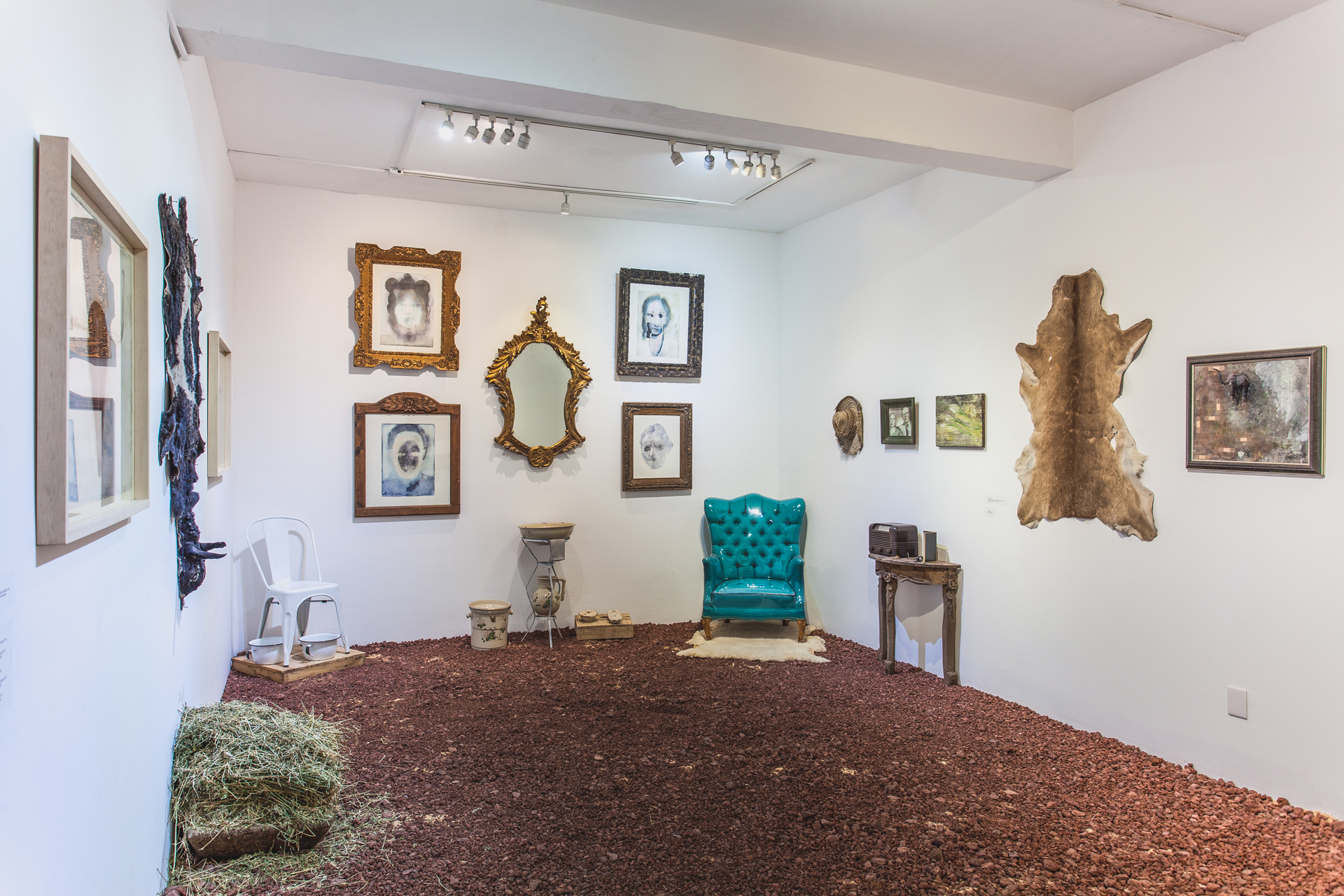
Sus técnicas de trabajo son igualmente amplias: grabado, acuarela, óleo, acrílico, bronce, plástico, cerámica y, sobre todo, técnica mixta. Digamos que lo “mixto” se impone en el trabajo de este artista que utiliza para la elaboración de pinturas y esculturas: madera y tierra, ramas secas, pelo de perro, piel de vaca, estiércol de caballo, pelotas de ping-pong, guajes, caparazones, chapopote, llantas de trailers, peluches, muñecos de plástico, caracoles y corcholatas, en mezclas y combinaciones híbridas.
Carmen Villoro explica, “La exposición “Del acstracto ranchero al naquismo mágico” muestra la vida del rancho a través de la mirada del artista. Con pinturas, esculturas y arte objeto, Gil Garea evoca muebles, adornos y símbolos que habitan las casas rurales del occidente de México, así como sus paisajes. El trópico y el páramo, el mar y el campo son abordados desde una posición estética cosmopolita, que es capaz de rescatar la poesía y la gracia de una cultura pueblerina entrañable. Con ello logra una resignificación de elementos culturales populares que forman parte de nuestra identidad.”
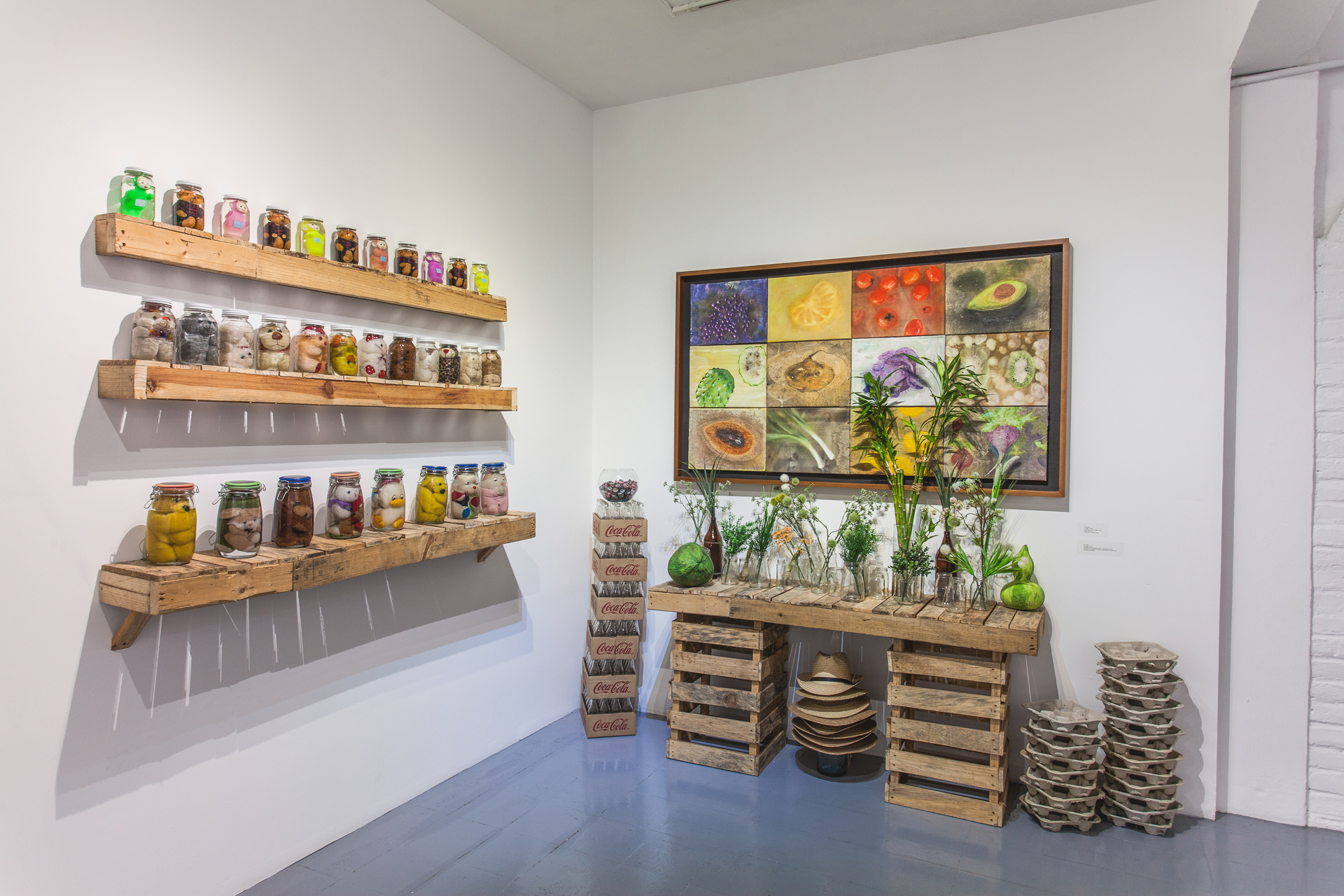
SOBRE EL ARTISTA:
Gil Garea nace el 28 de octubre de 1954 en la ciudad de México. A partir de 1982 y hasta 2002 vive en la ciudad de Colima. Del año 2003 a la fecha radica en la ciudad de Guadalajara. 1980 – 1982 Integra el Taller de Experimentación Gráfica (T.E.G.) del Centro de Investigación y Experimentación Plástica, INBA/SEP México, D.F.
Garea se refiere a su obra: “Me identifico con el informalismo, el “arte povera”, la neofiguración, el arte matérico, porque son corrientes dentro del arte que incorporan elementos que, al ser intervenidos y usados por el artista, resignifican la realidad. Me he sentido influido por artistas como Antoni Tàpies, Manuel Millares, Joseph Beuys,, Francisco Clemente, Jean Michel Basquiat, por citar algunos. Muchas veces lo que me gusta de ellos no es lo que pintan, sino su actitud artística, que han sentido el arte como una experiencia vital.”
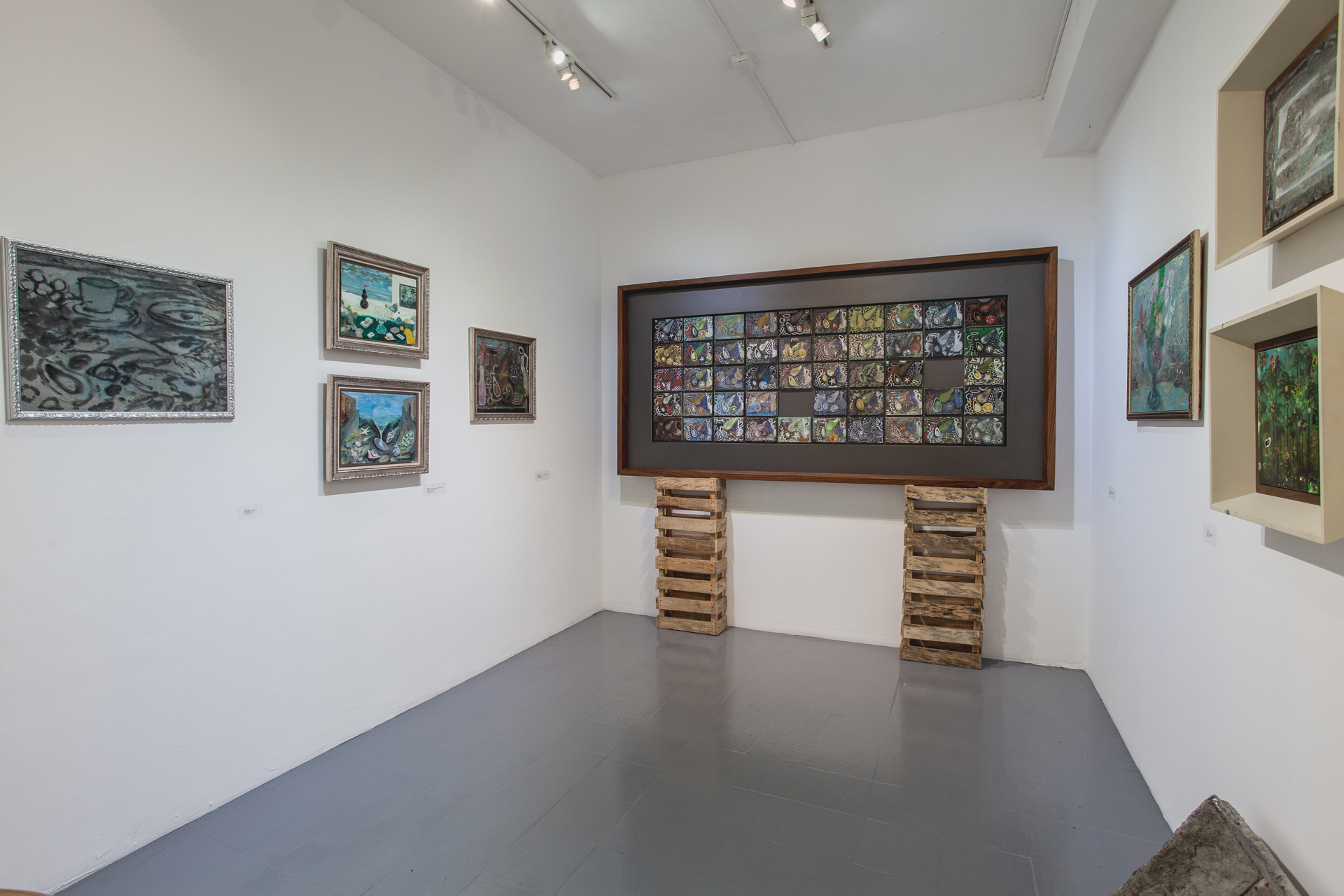
SOBRE LA CURADORA:
Carmen Villoro nació en México D.F. en 1958. Vive en Guadalajara desde el año 1985. Ha publicado varios libros de poesía y prosa poética, entre ellos: El tiempo alguna vez, El habitante, Jugo de Naranja, Obra negra, Espiga antes del viento, La algarabía de la palabra escrita y Leer a los amigos. Ha escrito también libros para niños como Amarina y el viejo Pesadilla, La media luna y Papalote, papelito. Fue directora de la revista de cultura Tragaluz. Es miembro del Sistema Nacional de Creadores de CONACULTA. Pertenece al consejo de la Cátedra Hugo Gutiérrez Vega de la Universidad de Guadalajara. Ha sido maestra e impartido talleres de poesía y literatura infantil durante 25 años y ha fungido como jurado en certámenes, becas y apoyos para creadores en diversos estados de la República Mexicana. Ha participado en proyectos interdisciplinarios con artistas de la danza, la música, el teatro y las artes visuales. Ha escrito textos para exposiciones y catálogos de diversos artistas visuales y ha participado como investigadora y curadora de algunas exposiciones de arte. Actualmente forma parte del equipo de curaduría para la renovación del Museo Regional de Guadalajara del INAH y es consejera del Consejo Estatal para la Cultura y las Artes de Jalisco.

En torno a la exposición se realizará un programa público que incluye lectura de poesía, un taller para niños, y una conferencia.
Del acstracto ranchero al naquismo mágico será posible gracias al generoso apoyo de David Schwendeman, Terence Reilly, y MEXLend Hipotecaria México.
Agradecemos a a nuestros patrocinadores: PAC Patronato de Arte Contemporáneo; Instituto Vallartense de Cultura; Milenio Jalisco; Cuervo 1800; El Terrible Cerveza; El Patio de Mi Casa, y Hotel Belmar.
Del acstracto ranchero al naquismo mágico
Work by Gil Garea
Curaduría: Carmen Villoro
Exhibition: October 8, 2016 to January 7, 2017
OPC, in collaboration with the Secretary of Culture, Jalisco; the Ex Convento del Carmen Museum and the Vallarta Institute of Culture, present Gil Garea’s Del acstracto ranchero al naquismo mágico, curated by Carmen Villoro.
This exhibition includes installation, painting, and graphic work by artist Gil Garea. His work covers a wide variety of topics, such as rural and urban landscapes, seascapes, everyday found objects, still-lives, and incorporates imagery from bullfighting, soccer, and insects to portraiture, toys, folk icons, and religious figures.

The techniques used by him are equally varied — engraving, watercolor, oil painting, acrylic, bronze, plastic, ceramic and, above all, mixed-media. It would be fair to say mixed media elements prevail in the work of Garea, who creates objects by combining, mixing, and hybridizing wood, dirt, dead branches, dog hair, leather, ping-pong balls, gourds, tar, freight-truck wheels, stuffed and plastic toys, shells, and bottle caps.
As Carmen Villoro explains: “Del acstracto ranchero al naquismo mágico illustrates country life from the point of view of the artist. Through his paintings, sculptures, and ready-mades, Gil Garea brings to mind the furniture, ornaments, and symbols that inhabit rural houses of western Mexico, as well as the landscapes of this area. The tropics and paramo, the sea and countryside are addressed from an aesthetic cosmopolitan point of view, one that rescues the poetry and the grace of beloved small-town culture.The artist is also redefining folk cultural elements that are a part of our identity”.

ABOUT THE ARTIST:
Gil Garea was born in Mexico City on October 28th, 1954. From 1982 to 2002, he lived in the city of Colima and has lived in Guadalajara since 2003. From 1980 to 1982, he was part of Mexico City’s Graphic Experimentation Workshop of the Center for Plastic Experimentation & Research, INBA/SEP.
Garea on his work: “I identify myself with Informalism, Arte Povera, Neo-Figurativism, and Matter painting, because these are artistic trends that mix various elements which redefine reality once they are used by the artist. I’ve been influenced by artists such as Antoni Tàpies, Manuel Millares, Joseph Beuys, Francisco Clemente, and Jean Michel Basquiat, to mention just a few. What I like about them is not necessarily their paintings per se, but their attitude towards art, the way they’ve experienced art as a vital experience.”

ABOUT THE CURATOR:
Carmen Villoro was born in 1958 in Mexico City. Since 1985, she lives in Guadalajara. She has authored several books of poetry and poetic prose, a few of them are: El tiempo alguna vez, El habitante, Jugo de Naranja, Obra negra, Espiga antes del viento, La algarabía de la palabra escrita, and Leer a los amigos. She has also written children’s books such as Amarina y el viejo Pesadilla, La media luna, and Papalote, papelito. She was the director of the cultural magazine Tragaluz. She is a member of CONACULTA’s Sistema Nacional de Creadores. She is a board member of Universidad de Guadalajara’s Hugo Gutiérrez Vega Chair. For 25 years, she has been a teacher and has given workshops on poetry and children’s literature. She has also been a member of juries for competitions, grants, and other supports for artistic creators in various states within Mexico. She has participated in interdisciplinary projects with other artists from fields such as dance, music, theater, and visual arts. She has written texts for exhibitions and catalogues of numerous visual artists, and has worked as a researcher and curator for art exhibitions. Currently, she is part of the curating team devoted to renovating the Guadalajara Regional Museum [Museo Regional de Guadalajara], dependent of INAH. She is an adviser for Jalisco’s Council for Culture & Arts [Consejo Estatal para la Cultura y las Artes de Jalisco].

A series of public programs will be produced in conjunction with the exhibition,
including a poetry reading, children’s workshops, and a lecture.
From “Del acstracto ranchero al naquismo mágico is made possible through the generous support of David Schwendeman, Terence Reilly, and MEXLend Mortgages.
We also thank our sponsors —Patronato de Arte Contemporáneo (PAC), Instituto Vallartense de Cultura, Milenio Jalisco, Cuervo 1800, El Terrible Cerveza, El Patio de Mi Casa, Hotel Belmar, and Villa Mercedes Boutique Hotel.
Usted Está Aquí: Aproximaciones Urbanas
Usted Está Aquí: Aproximaciones Urbanas
Curaduría: Oscar Moran
Exhibición: 28 de mayo al 30 de julio, 2016
—2° Aniversario de OPC—
Usted Está Aquí: Aproximaciones Urbanas es una exposición colectiva sobre las problemáticas sociales, territoriales, medio ambientales, arquitectónicas y culturales de la urbanización acelerada y desordenada producto del esquema de desarrollo y fomento turístico vigentes en el país. Con la participación de arquitectos, artistas y activistas se hace una crítica de las contradicciones y en algunos casos la marginación y exclusión que genera el modelo actual.
Utilizando a Puerto Vallarta como caso de estudio, la exposición brinda la oportunidad de visitar un una ciudad turística que no es, pero que podría llegar a ser. Nos sitúa en el campo de las ideas y presenta un plan incrementalmente producido a través de visiones independientes, diversas y heterogéneas que en conjunto ejemplifican un panorama de ciudad que responde de manera pertinente, responsable e incluyente, a los retos urbanos en el siglo XXI.
Las propuestas cubren aspectos de infraestructura cultural, movilidad, espacio público, modelos de desarrollo inmobiliario responsable, activadores de espacio público, manejo de aguas pluviales, conservación ambiental, preservación del patrimonio histórico, identidad, imaginario, y capital social.
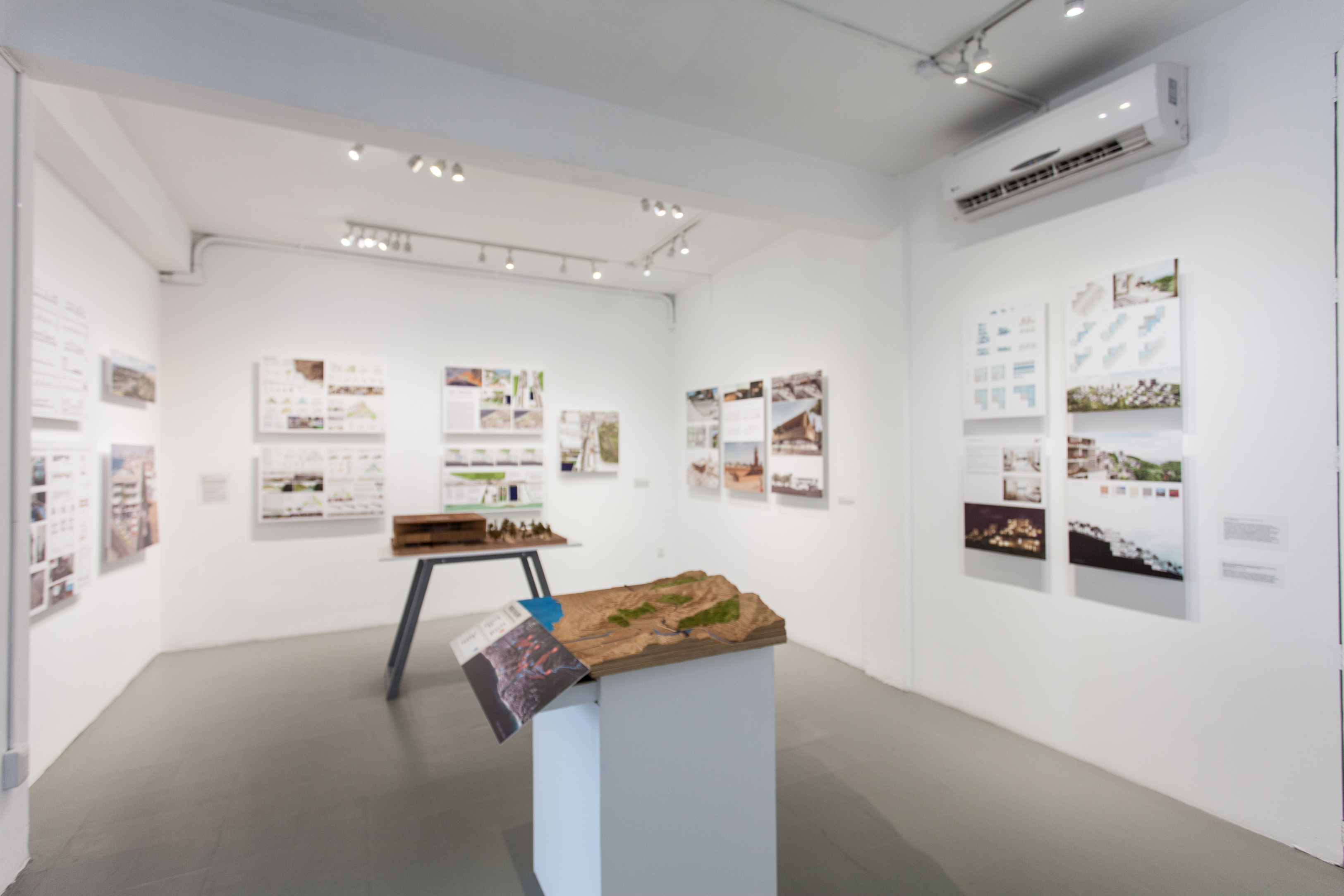
Usted Está Aquí es trabajo curatorial Oscar Moran Guillen, arquitecto por el ITESO y urbanista por la Universidad del Sur de California, involucrado a lo largo de su práctica en la coordinación de proyectos comunitarios y participación desde las iniciativas de autogestión y no-gubernamentales. Con la exposición se busca generar un espacio de diálogo y revisión de la dialéctica y las contradicciones de la dupla ciudad-destino turístico, un tema poco cubierto por la teoría y la crítica, aunque bien documentado desde la estadística.
La exposición marca el segundo aniversario de la Oficina de Proyectos Culturales (OPC) y coincide con el 98º aniversario de Puerto Vallarta. Participan en la exposición los arquitectos: Ana Olivera, Alfonso Baños, Jorge Ramírez, Alberto Reyes, Leonardo Díaz Borioli, Luis Echeverría, Arturo Dávila, Raúl Henderson, Oscar Moran, Javier Sánchez y Mauricio Rocha.
Así como los artistas y activistas: Davis Birks, Alejandra Ferrise, Josef Kandoll, Arturo Montero, Jimena Odetti, Ana Rifa, Javiera Pintocanales, Ana Joaquina Ramírez, Andres Reyes, Enrique Reyes y Eduardo Solórzano.

El trabajo curatorial organiza las piezas en tres ramas principales:
Investigación y Acervo: muestra datos duros, sondeos, mapeos, fichas y observaciones desde el campo de la investigación y la producción académica y brinda la oportunidad de una lectura analítica de aspectos de la ciudad relacionados con usos de suelo, densidad, capital social, patrimonio histórico, marginalidad e imaginario.
Reflexión y Crítica: muestra aspectos de la experiencia humana y dinámicas que surgen como consecuencia de políticas urbanas y planes de desarrollo, además de postular una crítica del estado de las cosas en materia urbana a través medios gráficos, instalación, fotografía y audiovisual.
Visión Urbana: muestra proyectos con potencial de impacto urbano y transformadores del discurso y modus vivendi de la ciudad, incluyentes de las necesidades y preocupaciones de la población local así como los retos urbanos de la realidad que rebasa al imaginario turístico.
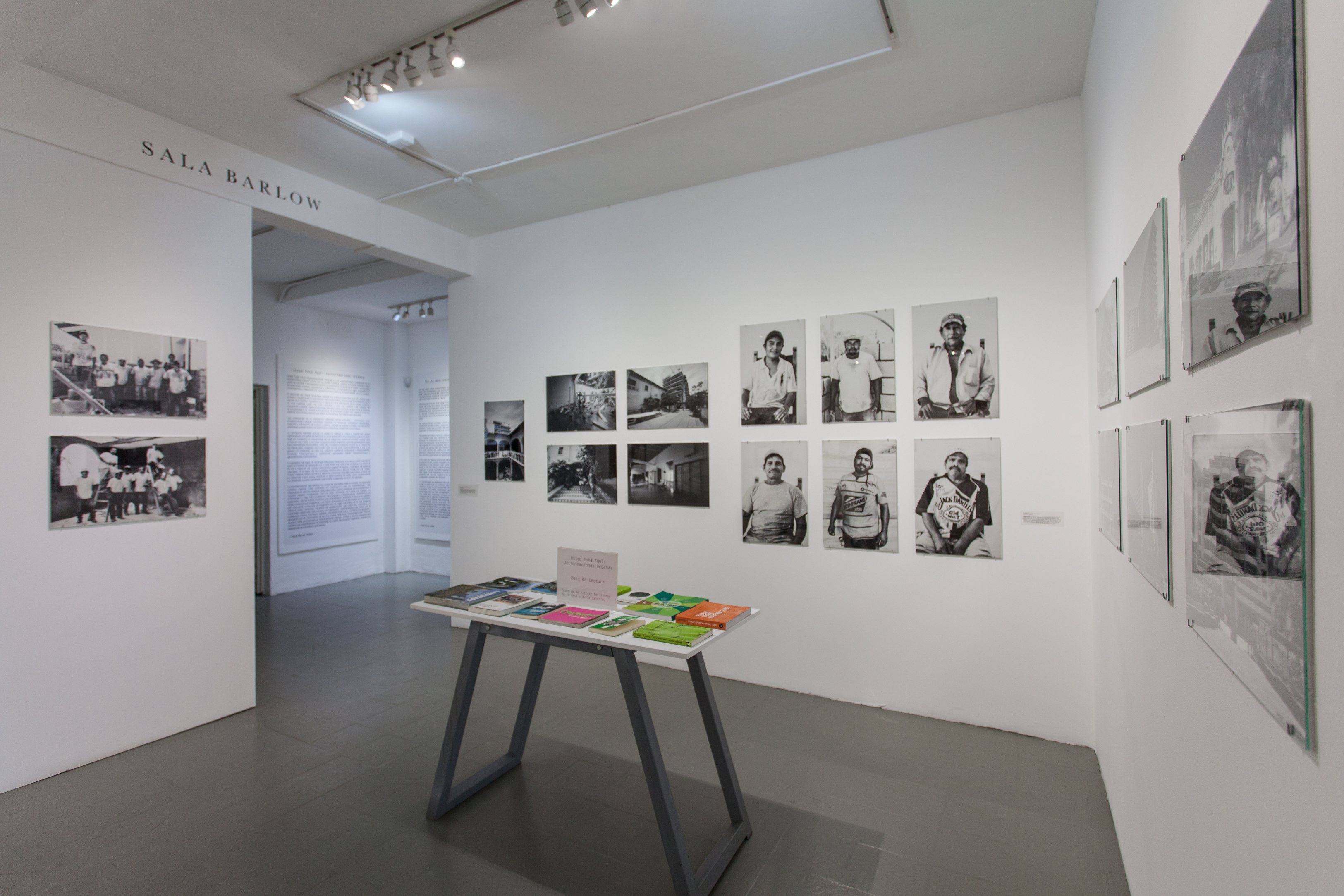
Oscar Moran Guillen (Guadalajara, Jalisco 1976) Lic. en Arquitectura por el ITESO (Guadalajara) y Mtro. en Planeación Urbana por Universidad del Sur de California (Los Ángeles). Es director y fundador del estudio de Arquitectura y Planeación RH+OM basada en Los Ángeles y Puerto Vallarta. Es socio fundador de la OPC (Oficina de Proyectos Culturales), así como miembro activo de diversos organismos no gubernamentales y de activismo urbano. Trabajó para AC Martin Partners y Gensler en Los Ángeles, California como coordinador de proyectos de Planeación Urbana. Ha sido investigador para el Centro de Desarrollo Económico de la Universidad del Sur de California, y para el Centro de Investigación y Documentación de la Casa en México, DF. Ha participado en proyectos de desarrollo ligado al transporte público (Transit Oriented Development) con la Autoridad de Transporte Público de Los Ángeles (LA MTA), y brindado consultoría en proyectos de infraestructura urbana y transporte público en México. Cuenta con participación en proyectos de Planeación Urbana en Corea, Estados Unidos, México y Medio Oriente.
Usted Está Aquí: Aproximaciones Urbanas inaugura el 28 de Mayo de 2016 en la Oficina de Proyectos Culturales Puerto Vallarta en la calle Juárez #598 esquina Aldama en el centro de Puerto Vallarta.
La Oficina de Proyectos Culturales (OPC) es una organización independiente y sin fines de lucro, dedicada a promoción del Arte Contemporáneo a través de exhibiciones, mesas redondas, iniciativas de arte público y programas de servicios educativos. Nace con la voluntad de contribuir a la reflexión sobre el entorno sociocultural y artístico contemporáneo, con la vocación de compartir con los habitantes y visitantes de Puerto Vallarta. OPC trabaja con distintos creadores como artistas, arquitectos, curadores, académicos y escritores que contribuyen a la construcción de nuestra noción de ciudad y aportan al panorama cultural ligado a Puerto Vallarta pero de alcance global.
You Are Here: Urban Approximations
Curator: Oscar Moran
Exhibition: May 28 to July 30, 2016
You Are Here, provides the opportunity to visit Puerto Vallarta, not as it is, but as it could become. It places us in the realm of ideas and discourse about the city, presenting a plan incrementally produced through independent, diverse, and heterogeneous ideas that together, exemplify a city panorama that pertinently responds to the urban challenges of the 21st century. This exhibition marks the second year anniversary of the opening of OPC (Office of Cultural Projects).
The exhibition brings together the vision of architects and urban planners, through work of critique and architectural proposals with great transformative potential for Puerto Vallarta. It covers aspects of cultural infrastructure, mobility, public space, real estate development models, responsible activators of public space, fluvial water management, environmental conservation, preservation of historical heritage, identity, imaginary, and social capital.

The exhibition is the result of curatorial efforts by the OPC team and Oscar Moran Guillén, architect and urban planner involved in urban projects through non-governmental organizations, as well as private practice. The exhibition seeks to create a space for dialogue and discussion about the urban reality of Puerto Vallarta and the potential for developing a critical longterm vision for future growth.
OPC annually organizes an exhibition dedicated to Puerto Vallarta on the occasion of its anniversary (both the gallery and the Port). You Are Here coincides with the 98th anniversary of Puerto Vallarta, opening a space that fosters discussion and dialogue about the urban possibilities of the present and the future.

The exhibition consists of three main themes
Reflection and Criticism: through artistic representation techniques (audio visual, installation, graphic), a human reality of the city is presented, experiential implications of current urban policy and city making decisions that shape the everyday lives of the city’s dwellers.
Research and Heritage: reflects upon hard data, surveys and mapping from an academic perspective and is presented graphically to provide the opportunity for a comprehensive and analytical and de-romanticized reading of the city in with its problems, opportunities, its legacy and its contrasts.
Urban Vision: displays projects with potential for broad impact and transformative qualities for the city, projects proposed but never built show through architectural representation such as models, plans, 3D visualizations, all independently produced mainly by architects and urban planners of Puerto Vallarta.

The exhibition features the participation of the following architects with practice in Puerto Vallarta: Ana Olivera, Alfonso Baths, Jorge Ramírez, Alberto Reyes, Leonardo Díaz Borioli, Luis Echeverria, Arturo Davila, Raul Henderson, Arturo Montero, as well as projects architects of national stature Javier Sanchez, Mauricio Rocha, Alejandro Zohn, and Ricardo Agraz.
It also features the participation of activists and artists such as Davis Birks, Javiera Pintocanales, Ana Joaquina Ramírez, Ana Rifa, Enrique Reyes, Alberto Reyes, Jimena Odetti, Eduardo Solórzano, Josef Kandoll, and Alejandra Ferrise Grant.
Un Atlas Decolonial: Videos de las Américas, 2010-1015
Un Atlas Decolonial: Videos de las Américas, 2010-1015
Curaduría: Pilar Tompkins Rivas
Exhibición: 12 de marzo al 7 de mayo, 2016
Desde el contexto hemisférico de las Américas, y cuestiones generales de la civilización y la cultura, “Un Atlas Decolonial: Videos de las Américas, 2010-2015”, presenta obras de vídeo recientes de diez artistas de Chile, Colombia, Guatemala, México, y los Estados Unidos lidiando con preguntas continuas del colonialismo y pos-colonialismo en un esfuerzo por encontrar “sitio” en la sociedad contemporánea. Las divisiones entre el desarrollo “material” y “espiritual” de la cultura, una distinción defendida por Alexander von Humboldt después de su expedición en América del Norte y del Sur a principios del siglo XIX, desanudan formaciones de conocimiento heredado y ancestral de la observación empírica. Tales relatos etnográficos de las Américas por los colonizadores europeos, son representativos de las controvertidas historias, que se han desarrollado durante los siglos pasados, y que se han replicado en la era moderna bajo nuevas fuerzas geopolíticas.

En el siglo XXI, los artistas contemporáneos sostienen activamente este legado de abordar nuevos discursos de la descolonización. Poner en primer plano las cuestiones de sitio y posicionalidad, estos artistas tratan de desestabilizar narrativas establecidas a través de perspectivas contra-hegemónicas. Presentado en tres viñetas, las obras de esta exposición consideran una asignación alternativa de la región, trazando nuevos cursos para el presente y futuro.
Reconfigurando Indigenismo
Obras de Laura Huertas Millán, Camilo Ontiveros, Javier Tapia y Carolina Caycedo, subvierten la exotizada vista de las culturas indígenas en la mirada europea, a través de la reafirmación de formaciones, creencias y prácticas de la identidad nativa. En Viaje en Tierra Otrora Contada (2011), Huertas Millán se apropia de los informes europeos tempranos del Nuevo Mundo mediante la organización de su propia expedición imitativa en un invernadero tropical en Francia, elaborando así un vistazo a las malas interpretaciones extremas engendradas en tales textos. Polvo Viajero (2014), de Camilo Ontiveros y Javier Tapia, tiene un puente sobre sitios a través de Chile, México y Los Ángeles, para trazar la circulación de las personas, economías y cultura, investigando paisaje, problemas de trabajo y la noción de la patria. Explorando las ideas de flujo y contención, Los Españoles La Nombraron Magdalena, Pero Los Nativos Le Llaman Yuma (2013), de Caycedo, cuenta la historia del río principal río de Colombia, el Magdalena, estableciendo paralelismos entre las formaciones de poder opresivas de presas de agua y los métodos militaristas de control social.

Desprendiendo el Tiempo
Rompiendo una noción lineal de tiempo, los vídeos de Tania Candiani, Naufus Ramírez-Figueroa, y Raul Baltazar, maniobran al espectador fuera de un reloj Gregoriano ordenado hacia ciclos abstractos. Tiempo de Circular/Circular Time (2013), pone en escena una banda de música en la Colombia rural en la formación de un reloj que gira, sin embargo, a través del aumento y disminución de la música, emerge un sentido cíclico y prolongado del paso del tiempo. Los períodos históricos se unen en Una Breve Historia de Arquitectura en Guatemala (2010, 103) de Ramírez- Figueroa, donde los trajes de los bailarines representando épocas arquitectónicas pre-Colombinas, Coloniales y Modernas delegan, denotando fallos en dichos períodos de imperio. La Visión de Tochtli (2011) por Raul Baltazar, muestra fragmentos de videos encontrados, reflejando un estado de sueño que cambia bruscamente, entretejiendo las mitologías de la cultura mexicana y que hacen referencia a la hora truncada que experimentamos en la era digital.

Interviniendo el Archivo
Los artistas Carlos Motta, Iván Argote, y Eamon Ore-Giron intervienen en las narrativas oficiales de lugares y eventos específicos, ampliando los límites del archivo. Deseos/ رغبات (2015) de Motta, se basa en el material histórico (y la ausencia de dichos documentos) relacionados a las clasificaciones legales y religiosas de las construcciones de identidad, para destacar cuestiones del cuerpo sexual y de género en el período colonial en Colombia y el tardío Imperio Otomano en Beirut. Promulgando los espacios imaginarios de las narrativas clandestinas, los protagonistas La Estrategia (2012) de Argote, reconstruyen las actividades diarias de los grupos revolucionarios en Colombia en las décadas de 1970 y 1980. Por último, en Morococha (2015), Ore-Giron intercede el anonimato de prácticas corporativas, económicas globales para hacer crónica de las secuelas de destrucción de una comunidad en el Perú debido a la compra de los recursos naturales de la región, por parte de un conglomerado transnacional.
Artistas:
Iván Argote, Raul Baltazar, Tania Candiani, Carolina Caycedo, Laura Huertas Millán, Carlos Motta, Camilo Ontiveros, Eamon Ore-Giron, Naufus Ramírez Figueroa, y Javier Tapia
Curador: Pilar Tompkins Rivas
Curador Asistente: Ana Iwataki
Un Atlas Decolonial: Videos de las Américas, 2010-2015, fue parte de Something Else, Off Biennial Cairo, en El Cairo, Egipto, que se exhibió del 28 de Noviembre al 28 de Diciembre, 2015.
http://
A Decolonial Atlas: Videos of the Américas, 2010-1015
Curator: Pilar Tompkins Rivas
Exhibition: March 12 to May 7, 2016
Drawing from the hemispheric context of the Americas , and broad questions of civilization and culture, A Decolonial Atlas: Videos from the Americas, 2010-2015 presents recent video works by ten artists from Chile, Colombia, Guatemala, Mexico, and the United States grappling with continued questions of colonialism and postcolonialism in an effort to locate “place” in contemporary society. Divisions between the “material” and “spiritual” development of culture, a distinction advocated by Alexander von Humboldt after his expedition in North and South America at the beginning of the nineteenth-century, untether inherited and ancestral knowledge formations from empirical observation. Such ethnographic accounts of the Americas by European colonizers are representative of the contested histories and that have unfolded over past centuries, and which have replicated in the modern era under new geopolitical forces. In the twenty-first century, contemporary artists actively contend with this legacy to broach new discourses of decolonization. Foregrounding questions of place and positionality, these artists seek to unsettle established narratives through counter-hegemonic perspectives. Presented in three vignettes, the artworks in this exhibition consider an alternative mapping of the region, charting new courses for the present and future.

Recasting Indigeneity
Works by Laura Huertas Millán, Camilo Ontiveros, Javier Tapia and Carolina Caycedo subvert the exoticized view of indigenous cultures in the European gaze, by reasserting native identity formations, beliefs and practices. In Viaje en Tierra Otrora Contada (Journey to a Land Otherwise Known) (2011), Huertas Millán appropriates early European reports of the New World by staging her own imitative expedition in a tropical greenhouse in France, thus drawing out the extreme misrepresentations engendered in such texts. T ravelling Dust (2014) by Camilo Ontiveros and Javier Tapia bridges sites across Chile, Mexico and Los Angeles to trace a circulation of people, economies, and culture, investigating landscape, issues of labor and the notion of homeland. Exploring the ideas of flow and containment, Caycedo’s S paniards Named Her Magdalena, But Natives Call Her Yuma (2013) tells the story of Colombia’s principal river, the Magdalena, drawing parallels between the oppressive power formations of water dams and militaristic methods of social control.
 Dislodging Time
Dislodging Time
Rupturing a linear notion of time, videos by T ania Candiani, Naufus Ramírez-Figueroa, and Raul Baltazar maneuver the viewer out of an ordered Gregorian clock into abstract cycles. C andiani’s T iempo Circular / Circular Time (2013), stages a marching band in rural Colombia in the formation of a rotating clock, yet through the waxing and waning of the music, a cyclical and prolonged sense of the passing of time emerges. Historical periods collide together in Ramirez-Figueroa’s A Brief History of Architecture in Guatemala (2010, 2013) , wherein the costumes of dancers representing pre-Columbian, Colonial, and Modern eras of architecture devolve, denoting the failures of such periods of empire. T ochtli’s Vision (2011) by Raul Baltazar s amples snippets of found videos mirroring an abruptly changing dream-like state, interweaving mythologies from Mexican culture, and referencing the truncated time we experience in the digital age.

Intervening the Archive
Artists Carlos Motta, Ivan Argote, and Eamon Ore-Giron intervene in the official narratives of specific places and events, broadening the confines of the archive. Motta’s D eseos / رغبات (Desires) (2015) draws from historic material (and the absence of such documents) relative to legal and religious classifications of identity constructs, to foreground issues of the sexual and gendered body in the colonial period in Colombia and the late Ottoman Empire in Beirut. Enacting the imagined spaces of clandestine narratives, the protagonists in Argote’s La Estrategia (2012) reconstruct the daily activities of revolutionary groups in Colombia in the 1970s and 1980s. Lastly, in M orococha (2015), Ore-Giron intercedes the anonymity of corporate, global economic practices to chronicle the aftermath of a community’s decimation in Peru due to a transnational conglomerate’s purchase of the region’s natural resources.
Artists:
Iván Argote, Raul Baltazar, Tania Candiani, Carolina Caycedo, Laura Huertas Millán, Carlos Motta, Camilo Ontiveros, Eamon Ore-Giron, Naufus Ramírez Figueroa, y Javier Tapia
Curator: Pilar Tompkins Rivas
Assistant Curator: Ana Iwataki
A Decolonial Atlas: Videos From the Americas, 2010-2015 is part of Something Else, Off Biennial Cairo, in Cairo, Egypt, running November 28 – December 28, 2015.
Impresiones de Transfrontera / Líneas Comunicantes: 25 Años de El Nopal Press
Impresiones de transfrontera / Líneas comunicantes:
25 años de El Nopal Press
Mi Cómico Favorito
(Fantasmagoría de Francesco X Siqueiros)
Exhibición: 13 de Enero al 5 de marzo, 2016
El taller de El Nopal Press, quien el artista Francesco X Siqueiros fundó en 1990 en Los Ángeles, ha propiciado un diálogo artístico entre creadores mexicanos, estadunidenses, y chicanos. De allí que la muestra presenta obra de John Baldessari, Dr. Lakra, Silvia Gruner, Daniel J. Martínez, Rubén Ortiz Torres, Vicente Razo, Daniela Rosell, Laureana Toledo, Eloy Tarcisio, Alberto Tovalín y Yishai Jusidman, entre los 35 artistas representados en la exposición.
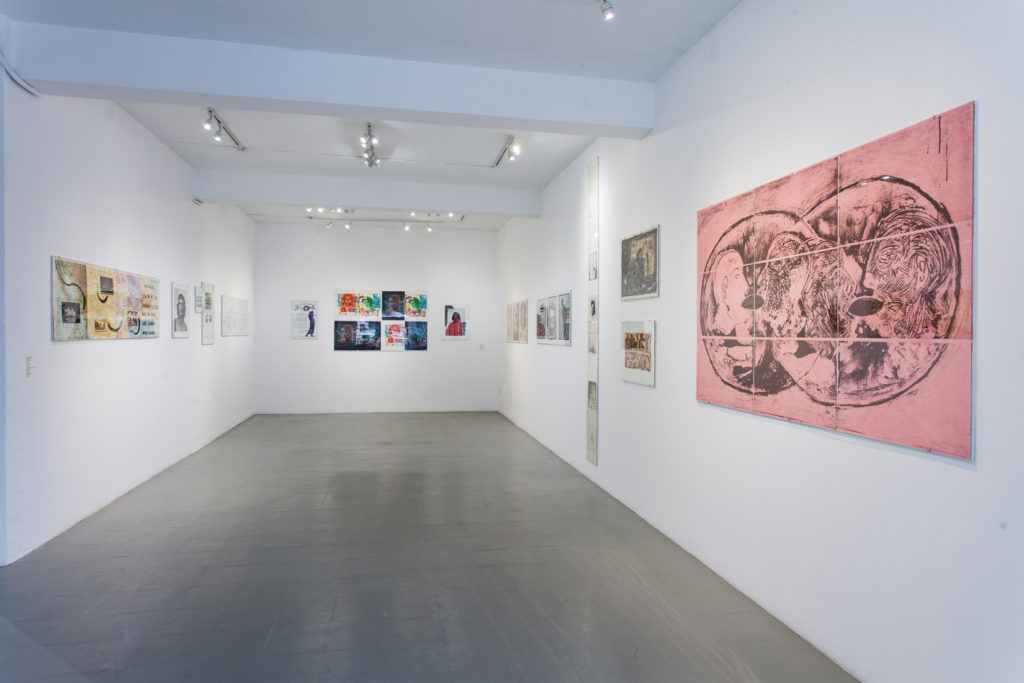 Entre las casas editoriales independientes de bellas artes, guiadas por el espíritu de colaboración del artista y la empresa, El Nopal Press se distingue por su enfoque en el trabajo de artistas que exploran temas fronterizos y las complejas relaciones culturales que existen entre México y Estados Unidos. Más específicamente, las ideas traídas hacia adelante a través de la labor de la editorial, teniendo más que ver con una conversación en relación a la idea de la frontera en lugar de su manifestación física como un fenómeno cartográfico, barrera económica y social, o límite penetrable. Como participantes en un diálogo alternativo que se extiende mucho más allá de la corriente principal creativa, los artistas de El Nopal han venido a vivificar y ampliar el complejo intercambio intercultural entre estos dos países. De hecho, las imágenes producidas por El Nopal son elementos clave en este discurso, y se numeran entre sus características, esas representaciones que hablan a través de imágenes, en lugar de palabras.
Entre las casas editoriales independientes de bellas artes, guiadas por el espíritu de colaboración del artista y la empresa, El Nopal Press se distingue por su enfoque en el trabajo de artistas que exploran temas fronterizos y las complejas relaciones culturales que existen entre México y Estados Unidos. Más específicamente, las ideas traídas hacia adelante a través de la labor de la editorial, teniendo más que ver con una conversación en relación a la idea de la frontera en lugar de su manifestación física como un fenómeno cartográfico, barrera económica y social, o límite penetrable. Como participantes en un diálogo alternativo que se extiende mucho más allá de la corriente principal creativa, los artistas de El Nopal han venido a vivificar y ampliar el complejo intercambio intercultural entre estos dos países. De hecho, las imágenes producidas por El Nopal son elementos clave en este discurso, y se numeran entre sus características, esas representaciones que hablan a través de imágenes, en lugar de palabras.
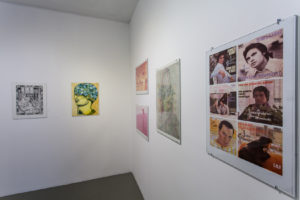
En 1990, en el momento de la institución de El Nopal Press en Los Ángeles, ésta conversación bilateral del arte contemporáneo apenas comenzaba. Los pocos programas que existían tendían a enfatizar las agendas gubernamentales o las diferencias culturales a expensas de un cambio más profundo, y había poco o ningún precedente para el desarrollo de un modelo cooperativo. Si los artistas de la Ciudad de México parecían menos preocupados por cuestiones de identidad cultural, otros al norte de la frontera, en particular los artistas chicanos de Los Ángeles, se caracterizaron como estafadores provinciales y apropiacionistas. A pesar de las instancias de ascendencia compartida, las barreras del idioma y la cultura, se mantuvieron. Después de varios años de viajes e investigaciones, el fundador de El Nopal Press, Francesco Siqueiros, un artista y maestro de la imprenta, íntimamente familiarizado con los mundos del arte de Los Ángeles y Ciudad de México, unió estos dos mundos.
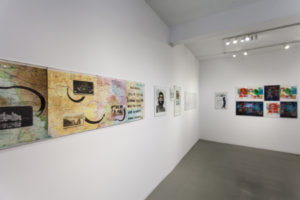
Si bien, la historia de El Nopal está estrechamente identificada con artistas mexicanos y chicanos, su esfuerzo principal es la producción de arte que de alguna manera incorpore la frontera como una idea. Las impresiones producidas por los artistas, ejecutadas como litografías, xilografías, aguafuertes y combinaciones de estos procesos, expresan consideraciones que van desde lo social y lo ético, a las cuestiones de identidad.
Artistas:
Kevin Appel • Judi Baca • John Baldessari • Mariana Botey • Carolyn Castaño • Yreina Cervantez • York Chang • Joe David • Victor Estrada • Espectro Rojo • Salomon Huerta • Diane Gamboa • Harry Gamboa, Jr. • Gronk • Silvia Gruner • Cameron Jamie • Glen Kaino • Dr. Lakra• Daniel Joseph Martinez • Lino Martinez • Eamon Ore-Giron• Sandra de la Loza•Rocio Maldonado • Jose Montoya • Mario Rangel Faz • Rubén Ortiz Torres • Renee Petropoulous•Vicente Razo • Daniela Rossell • Analia Saban • Eloy Tarcisio • Laureana Toledo • John Valadez • German Venegas • Yishai Jusidman

Además, hay 14 obras gráficas producidas por Francesco X Siqueiros, de un portafolio titulado “Mi Cómico Favorito (Fantasmagoría de Francesco X Siqueiros)”. La obra gráfica adquiere significado conforme se elabora y se procesa asumiendo la tarea de diseminar el concepto como documento histórico.
Este proyecto gráfico fue producido usando la litografía experimental como método de reproducción, elaborando texturas, usando metodologías deliberadas y arbitrarias para darle sentido a la riqueza metafórica de la comedia.
Los cómicos que se presentan en el portafolio vienen de la tradición del Teatro de Carpa, del humor radical, abyecto e irreverente que responde al fracaso de la modernidad y que al mismo tiempo irónicamente, por medio de la difusión del cine y televisión, forma parte del poder político y de sus mecanismos de control social.
La representación performática de la comedia, entonces, tiene primero el contexto de la Carpa donde sealberga el origen creativo y el otro la difusión cinemática de la misma. Esta última tiene una doble función como dispositivo, por un lado es una voluntad de poder nacionalista ligada a la unificación e institucionalización del estado capitalista moderno y el otro para instigar una parte intrínseca a la economía psíquica sin ideología; el deseo de romper con la represión por medio del humor .
El humor en el psicoanálisis se identifica con la sombra (eso que niegas que eres: lo que se negocia como parte de la economía psíquica) que surge de una agresión inconsciente como una manera de eludir la censura interna. Las carcajadas y el breve reconocimiento de esa ironía existencial de la condición humana es el deleite momentáneo que unifica la alteridad en el chiste y en el humor.
Los Cómicos son Curanderos que promueven una economía psíquica saludable, iluminando el lado obscuro de nuestro ser, reconociendo lo abyecto en nosotros y en lo que nos rodea negociando lo heterogéneo en la sociedad como parte vital de la existencia.
El acto de imprimir con toda la facultad expresiva de ejecución fue de orden alquímico y de ritual performático. El acto con la acción repetitiva y relamida es una manera de convocar (fantasmagoría) la presencia de los cómicos o de la sombra psíquica colectiva. Que por medio de su muy rigurosa producción, eleva y separa la imagen impresa del material de origen (conversión de material base al oro).
El portafolio-capitulo I, incluye los siguientes cómicos:
Mario Moreno (Cantinflas)
Gaspar Henaine Peréz (Capulina)
Antonio Espino Mora (Clavillaso)
Xavier López Rodriguez (Chabelo)
Manuel Valdés (Loco Valdés)
Adalberto Martinez (Resortes)
German Valdés (Tin Tan)
Impresiones de transfrontera / Líneas comunicantes: 25 años de El Nopal Press viajó al Ex -Convento del Carmen en Guadalajara; al Instituto de Artes Gráficas de Oaxaca; y por último a Los Ángeles. A la Oficina de Proyectos Culturales le gustaría reconocer el apoyo por parte del Instituto Vallartense de Cultura y a la Secretaría de Cultura de Jalisco.
Curadores: Dra. Mariana Botey and Francesco X Siqueiros
Mariana Botey es una historiadora de arte, curadora y artista nacida en la Ciudad de México. Recibió su PhD. en Estudios Visuales de la Universidad de California, Irvine y es Profesora Asociada en UCSD. Su libro Zonas de Disturbio: Espectros del México Indígena en la Modernidad, acaba de ser publicado por Siglo XXI Editores. Desde el 2009 es miembro fundador de la editorial y comité curatorial de El Espectro Rojo (The Red Specter), y desde el 2011 de Zona Crítica, una colección editorial en colaboración con Siglo XXI Editores, la UNAM y la UAM. Vive y trabaja en San Diego y la Ciudad de México.
Francesco X Siqueiroses un artista y educador. Tiene más de 20 años de experiencia, enseñando grabado y dibujo en varias universidades y escuelas como la Universidad de California en Los Ángeles; la Universidad de California en Santa Cruz; la Universidad de California del Sur; Otis College de Arte y Diseño; la Universidad Estatal de California en Northridge; y en el Art Center College of Design. En 1990 Siqueiros fundó El Nopal Press, una casa editorial de edición limitada de arte. Ha impreso y colaborado con diversos artistas como John Baldessari. Ed Ruscha, Lari Pittman, John Valadez, y Lita Albuquerque, entre otros. Es licenciado por la Universidad de California en Berkeley y la Universidad de París, Sorbonne.
La Oficina de Proyectos Culturales (OPC) es una organización independiente y sin fines de lucro, dedicada a fomentar el diálogo a través de exhibiciones, mesas redondas, arte público y programas de educación de las artes. OPC trabaja con artistas, arquitectos, curadores, académicos y escritores creadores de ideas que construyen nuestra noción de ciudad y un panorama cultural ligado a Puerto Vallarta pero de alcance global. Nace con la voluntad de contribuir a la reflexión sobre el entorno sociocultural y artístico contemporáneo y con la vocación de compartir con Puerto Vallarta y sus visitantes.
Impressions of transfrontier / Connecting lines:
25 years of El Nopal Press
&
My Favorite Comic
(Phantasmagoria by Francesco X Siqueiros)
Exhibition: January 13 to March 5, 2016
(Puerto Vallarta, January 2016) Oficina de Proyectos Culturales is proud to present the contemporary art exhibition Impressions of transfrontier / Connecting lines: 25 years of El Nopal Press, curated by Mariana Botey. The El Nopal Press workshop, founded by artist Francesco X Siqueiros in 1990 in Los Angeles, has led to a 25-year artistic dialogue between Mexican, American, and Chicano artists. The exhibition presents works by well-known artists from both sides of the border, including John Baldessari, Dr. Lakra, Silvia Gruner, Daniel J. Martinez, Ruben Ortiz Torres, Vicente Razo, Daniela Rosell, Laureana Toledo, Eloy Tarcisio, Alberto Tovalín, and Yishai Jusidman; they are among the 35 artists represented in the exhibition.

Among independent fine arts presses guided by the collaborative spirit of artist and enterprise, El Nopal Press is distinguished by its focus on the work of artists who explore border issues, the complex cultural relationships that exist between Mexico and the United States. More specifically, the ideas brought forward through the work of the press have more to do with a conversation concerning the idea of the border rather than its physical manifestation as a cartographic phenomenon, economic and social barrier, or penetrable boundary. As participants in an alternative dialogue that extends well beyond the creative mainstream, the artists of El Nopal have come to vivify and expand the complex intercultural exchange between these two countries. In fact, the images produced by El Nopal are key elements in this discourse, and are numbered among its signifiers, those representations that speak through pictures, not in words.

In 1990, at the time of the founding of El Nopal Press in Los Angeles, this bilateral conversation of contemporary art was just beginning. The few programs that did exist tended to emphasize governmental agendas or cultural differences at the expense of a deeper exchange, and there was little or no precedent for the development of a cooperative model. If artists from Mexico City seemed less concerned with matters of cultural identity, others north of the border, particularly the Chicano artists of Los Angeles, were characterized as provincial tricksters and appropriationists. In spite of instances of shared ancestry, barriers of language and culture remained. After several years of travel and research, El Nopal founder Francesco Siqueiros, an artist and master printer intimately familiar with the art worlds of both Los Angeles and Mexico City, brought these worlds together.

While the history of El Nopal is closely identified with Mexican and Chicano artists, its primary thrust is the production of art that in some way incorporates the border as an idea. The prints produced by these artists, executed as lithographs, woodcuts, etchings and combinations of these processes, express considerations that range from the social and the ethical to issues of identity.
Artists:
Kevin Appel•Judi Baca•John Baldessari•Mariana Botey•Carolyn Castaño•Yreina Cervantez•York Chang•Joe David•Victor Estrada•Espectro Rojo•Salomon Huerta•Diane Gamboa•Harry Gamboa, Jr.•Gronk•Silvia Gruner•Cameron Jamie• Glen Kaino•Dr. Lakra•Daniel Joseph Martinez•Lino Martinez•Eamon Ore-Giron• Sandra de la Loza•Rocio Maldonado•Jose Montoya•Mario Rangel Faz• Rubén Ortiz Torres• Renee Petropoulous•Vicente Razo•Daniela Rossell•Analia Saban• Eloy Tarcisio•Laureana Toledo•John Valadez•German Venegas•Yishai Jusidman
In addition, there are 14 prints produced by Francesco X Siqueiros from a portfolio titled My Favorite Comic (Phantasmagoria by Francesco X Siqueiros). The graphic work acquires meaning as it is produced and processed assuming the task of spreading the concept as a historical document.
This graphic project was produced using experimental lithography as a means of reproduction, creating textures, using deliberate and arbitrary methodology to make sense of the metaphorical richness of comedy.
Comics presented in the portfolio come from the tradition of Theater Marquee, the radical, abject and irreverent humor that responds to the failure of modernity and at the same time ironically, through the distribution of film and television, takes part of the political power and its social control mechanisms.
The performative representation of comedy, then, is the context of the Tent that houses the creative origin and the other, the cinematic dissemination of the first. The latter has a dual function as a mechanism, on one hand is a will of nationalistic power linked to the unification and institutionalization of the modern capitalist state and the other for instigating an intrinsic part of the psychic economy without ideology; the desire to break with repression through humor.
Chapter I of the portfolio includes the following comics:
Mario Moreno (Cantinflas)
Gaspar Henaine Peréz (Capulina)
Antonio Espino Mora (Clavillaso)
Xavier López Rodriguez (Chabelo)
Manuel Valdés (Loco Valdés)
Adalberto Martinez (Resortes)
German Valdés (Tin Tan)

Impressions of transfrontier / Connecting lines: 25 years of El Nopal Press will travel to the Ex -Convento del Carmen in Guadalajara; the Institute of Graphic Arts of Oaxaca; and finally to Los Angeles. Oficina de Proyectos Culturales would like to acknowledge the support from the Vallarta Institute of Culture and the Ministry of Culture of Jalisco.
A second part of the exhibition will open on January 27, with an exhibition by La Raya Gráfica.
Curators: Dra. Mariana Botey and Francesco X Siqueiros
Mariana Botey is an art historian, curator and artist born in Mexico City. She received her PhD. in Visual Studies from the University of California, Irvine and is an Associate Professor at UCSD. Her book Disturbance Zones: Spectres of Indigenous Mexico in Modernity, has just been published by Siglo XXI Editores. Since 2009 she became a founding member of the editorial and curatorial committee of The Red Specter, and since 2011 of Critical Zone, an editorial collection in collaboration with Siglo XXI Editores, UNAM and UAM. She lives and works in San Diego and Mexico City.
Francesco X Siqueiros is an artist and educator. He has over 20 years of experience, teaching printmaking and drawing at various universities and schools like the University of California, Los Angeles; the University of California, Santa Cruz; University of Southern California; Otis College of Art and Design; California State University at Northridge; and the Art Center College of Design. In 1990 Siqueiros founded El Nopal Press, a publisher of limited edition art. He has printed and collaborated with diverse artists such as John Baldessari. Ed Ruscha, Lari Pittman, John Valadez, and Lita Albuquerque, among others. He graduated from the University of California, Berkeley and the University of Paris, Sorbonne.
The Office of Cultural Projects (OPC) is an independent, non-profit organization dedicated to promoting dialogue through exhibitions, panel discussions, public art and educational programs for the arts. OPC works with artists, architects, curators, academics and writers, creators of ideas that build our notion of city and cultural landscape linked to Puerto Vallarta but with global reach. Born with the desire to contribute to the reflection on contemporary cultural and artistic environment and with the aim of sharing with Puerto Vallarta and its visitors.
Carteles por Ayotzinapa: Primer Bienal Internacional de Carteles Oaxaca
Carteles por Ayotzinapa:
Primer Bienal Internacional de Carteles Oaxaca
Francisco Toledo: 43 Papalotes
Matt Black: Guerrero, Monstruo en las Montañas
Rafael Lozano-Hemmer: Nivel de Confianza
Exhibición: 26 de Septiembre al 14 de noviembre, 2015
(Puerto Vallarta, Septiembre 2015) Oficina de Proyectos Culturales tiene el honor de presentar la siguiente exhibición de arte contemporáneo enfocada en remarcar la importancia del evento de la desaparición de los 43 normalistas, quienes desaparecieron desde hace un año y cuyo caso no ha sido resuelto aún. Esta muestra es un homenaje a las víctimas e incluye carteles, papalotes, video y una instalación interactiva en el aniversario de los acontecimientos que no debemos olvidar.
En enero del año 2015, Francisco Toledo lanzó la convocatoria Carteles Por Ayotzinapa provocando la participación internacional de cerca de 700 participantes alrededor del mundo. Sorprendentemente, Irán fue el país que más participó seguido con la llegada de propuestas de países como Italia, España, Costa Rica, Cuba, Portugal, Japón, Francia, entre otros. El objetivo para el maestro Toledo era reflexionar creativa y pacíficamente en torno al caso Ayotzinapa.
En México, la tradición del cartel se vio tocada por la comprometida estructura narrativa del Estridentismo, el movimiento artístico y literario creado por Manuel Maples Arce en 1921, cuya línea política -influida por el futurismo italiano-, se transmitía con las hojas volantes: un llamado público a los intelectuales mexicanos y al público en general para constituir una sociedad artística sustentada en la transformación del mundo. Estas primeras alertas a la sensibilidad nacional dieron pie al surgimiento, en 1937, del Taller de Grafica Popular, fundado por el grabador Leopoldo Méndez, cuya producción se dirigía a beneficiar “los intereses progresistas y democráticos del pueblo mexicano, principalmente en su lucha contra la reacción fascista”.
Los carteles que integran el catálogo de “Carteles por Ayotzinapa” son resultado de la plural y ambiciosa convocatoria lanzada por el Instituto de Artes Gráficas de Oaxaca en diciembre de 2014, apenas 3 meses después del deleznable y violentísimo evento que provocó la desaparición de los 43 normalistas en el estado de Guerrero.
Tan comprometida con la lucha social y la denuncia, como con los apartados estéticos y comunicativos, la convocatoria “Carteles por Ayotzinapa” ejemplifica con claridad el formidable potencial del cartel como agente provocador de reacciones, de opiniones, de irritación y de reflexión.
El maestro Toledo también elaboró con la ayuda de trabajadores del Taller “Arte y Papel” de San Agustín Etla, 43 papalotes con los rostros de los estudiantes de la Escuela Normal Rural, Raúl Isidro Burgos de Ayotzinapa, Guerrero.
Toledo explicó que su idea, además de buscar a los estudiantes por los aires y no sólo por los suelos, proviene de una tradición antigua que practican en Juchitán. La gente utiliza los papalotes para atraer las almas de las personas que han fallecido. Esto no significó para el artista que estuvieran ya muertos los estudiantes, sino que buscaba traerlos a casa con sus familias, llamándolos desde los cielos con sus papalotes.
Nivel de Confianza, por el artista mexicano Rafael Lozano Hemmer, es una pieza de arte interactivo que consta de una cámara de reconocimiento facial entrenada con los rostros de los 43 estudiantes desaparecidos de la escuela normalista de Ayotzinapa en Iguala, México. Cuando usted se sitúa frente a la cámara, el sistema utiliza algoritmos para encontrar los rasgos faciales de los estudiantes mas parecidos a los suyos, generando un Nivel de Confianza que muestra que tan acertada es esta coincidencia, expresada como porcentaje.
“Es poco probable que la pieza encuentre a los estudiantes debido a que el sistema de reconocimiento facial está entrenado con las pocas fotos que están disponibles públicamente, es decir, las fotos de su credencial de identidad, las cuales adicionalmente son de mala calidad y de hace un par de años en muchos casos, además la pieza solo será expuesta en algunos lugares, como universidades y museos, donde es poco probable que se encuentren los estudiantes. Pero el espíritu de este proyecto es continuar la búsqueda”, explica en entrevista el artista cuya obra integra colecciones como la del Museo de Arte Moderno de Nueva York o de la colección Tate Modern en Londres.
Guerrero: Monstruo en las montañas es un cortometraje documental de 7 minutos basado en la obra del fotógrafo Matt Black, producido y publicado en la serie de videos y cortometrajes de The New Yorker. El filme revela, cómo las familias de los desaparecidos están haciendo frente a la pérdida, aún sin explicación, de sus seres queridos, y cómo los ciudadanos están luchando para protegerse a sí mismos, y para preservar la esperanza.
El periodista de la revista estadounidense, quien ha sido galardonado por la Fundación Robert F. Kennedy Memorial, por la Fundación World Press Photo y la Fundación Magnum,va recorriendo diversos municipios que conforman la zona geográfica de la Montaña del estado de Guerrero. Mientras se observan fotografías y fragmentos de video, se escucha una voz en off: la madre de uno de los normalistas desaparecidos. Se trata de una sentida carta de la mujer para su hijo Abel García Hernández.
“Querido hijo, hoy que no estás conmigo siento un dolor tan grande que no puedo explicar con palabras. Creo que mi corazón se me hace más y más pequeño. Siento como poco a poco se me va desgarrando dentro de mí”, dice uno de los fragmentos de la misiva.
Se llevarán a cabo una serie de discusiones de mesa redonda; lectura de poesía; y pláticas con los artistas a lo largo de la exposición.
OPC desea agradecer a la familia Barlow la donación generosa del uso del edificio; también al Maestro Francisco Toledo; Inari Reséndiz; Laurena Toledo; Instituto de Artes Gráficas de Oaxaca; Instituto Nacional de Antropología e Historia; Matt Black; y Rafael Lozano Hemmer
Francisco Toledo es un artista plástico mexicano que también tiene una destacada labor como activista, luchador social, ambientalista, promotor cultural y filántropo, ha apoyado numerosas causas enfocadas a la promoción y conservación del patrimonio artístico mexicano, orientada al libre acceso a la formación artística y el cuidado del medio ambiente.
Toledo es considerado uno de los mayores artistas vivos de México, cuenta con amplio reconocimiento internacional. Es un experto impresor, dibujante, pintor, escultor y ceramista. El artista zapoteco se ha dedicado a promover y difundir la cultura y las artes de su estado natal, Oaxaca, donde actualmente reside. Con apoyo de otras instituciones fundó en octubre de 1997 el Taller Arte Papel Oaxaca, instalado en la antigua planta hidroeléctrica “La Soledad”, en San Agustín Etla. Dentro de este contexto, fundó Ediciones Toledo, que en 1983 publicó su primer libro, y en 1988 fundó el Instituto de Artes Gráficas de Oaxaca (IAGO).
A iniciativa suya se creó en 2006 el Centro de las Artes San Agustín (CaSa) en San Agustín Etla, 17 km al norte de Oaxaca de Juárez, el primer centro de arte ecológico de Latinoamérica, en donde se produce y estudia fotografía, gráfica digital, diseño textil, así como preservación del patrimonio y arte enfocados al medio ambiente.¡
Rafael Lozano-Hemmer (nacido en 1967 en la Ciudad de México) es un artista electrónico que trabaja con ideas de la arquitectura, teatro tecnológico y performance. Vive y trabaja en Montreal y Madrid. Lozano-Hemmer es mejor conocido por sus intervenciones interactivas en espacios públicos en Europa, Asia y América. Sus instalaciones utilizan tecnologías como la robótica, proyecciones, sensores y redes de comunicación para interrumpir la homogeneización urbana con plataformas para la participación.
En 1999 creó la instalación “Alzado Vectorial” donde participantes en Internet podían controlar cañones anti-aéreos sobre el Zócalo de la Ciudad de México. La pieza se repitió en Vitoria en el 2002, en Lyon 2003, en Dublín 2004 y en Vancouver para las olimpiadas de invierno del 2010. Fue el primer representante oficial de México en la Bienal de Venecia, con una exposición individual en el Palazzo Soranzo Van Axel en la 52a Exposición Internacional de Arte del 2007.
Matt Black es originario del Valle Central de California, una región agrícola en el corazón del estado. Su trabajo ha explorado las conexiones entre migración, pobreza, la agricultura y el medio ambiente en su natal California rural y en el sur de México por dos décadas. Su trabajo ha sido reconocido por la Fundación en Memoria de Robert. F Kennedy, la Fundación Magnum de Fondos de Emergencia, el Centro Pulitzer en Reportajes de Crisis, Fotografías del Año Internacional, Prensa Mundial de Fotografía, la Fundación Alexia, el Centro para la Innovación Cultural, entre otros.
Posters for Ayotzinapa:
First International Biennial of Oaxaca Posters
Francisco Toledo: 43 Kites
Matt Black:
Guerrero: Monster in the Mountains
Rafael Lozano-Hemmer: Level of Confidence
Opening September 26th 7 to 9PM
Exhibition from September 26th to November 14th, 2015
598 Juárez, esq. Aldama, Centro
(Puerto Vallarta, September 2015) Oficina de Proyectos Culturales is proud to present the next exhibition of contemporary art focused on emphasizing the importance of the event of the disappearance of the 43 normal school students, who disappeared a year ago and whose case has not been solved yet. This exhibition is a tribute to the victims and includes posters, kites, video, and an interactive installation on the anniversary of the events we must not forget.
In January of 2015, Francisco Toledo released the international call for Posters for Ayotzinapa, involving nearly 700 participants around the world. Surprisingly, Iran was the country with the most submissions, followed by the proposals from countries such as Italy, Spain, Costa Rica, Cuba, Portugal, Japan, France, among others. The goal for the master Toledo was to reflect creative and peacefully regarding the Ayotzinapa case.
In Mexico, the tradition of poster making was touched by the committed narrative structure of Stridentism, the artistic and literary movement created by Manuel Maples Arce in 1921, whose political line -influenced by Italian futurism-, was transmitted through leaflets: a public call to Mexican intellectuals and the public in general to form an artistic society sustained by the transformation of the world.
These early warnings to the national sensibility gave rise to the sprouting in 1937 of the “Taller de Gráfica Popular”, founded by writer Leopoldo Mendez, whose production was devoted to benefit “the progressive and democratic interests of the Mexican people, especially in their fight against fascist reaction “.
The posters that make up the catalog of “Posters for Ayotzinapa” are the result of the plural and ambitious call launched by the Institute of Graphic Arts of Oaxaca in December 2014, just 3 months after the despicable and very violent event that caused the disappearance of the 43 normal school students in the state of Guerrero.
As committed to the social struggle, and denunciation, as with the aesthetic and communicative sections, the call “Posters for Ayotzinapa” clearly illustrates the tremendous potential of posters as an agent provocateur of reactions, opinions, irritation and reflection.
Master Toledo also elaborated, with the help of workers of the workshop “Art and Paper” of San Agustin Etla, 43 kites with the faces of the students of the Normal Rural School, Raúl Isidro Burgos Ayotzinapa, Guerrero.
Toledo explained that his idea, in addition to looking for the students through the air and not only on the ground, comes from an old tradition practiced in Juchitan. People use kites to attract the souls of people who have died. For the artist this did not mean that the students were already dead, but sought to bring them home with their families, calling from the heavens with his kites.
Level of Confidence by Mexican artist Rafael Lozano Hemmer is an interactive art piece consisting of a facial recognition camera trained with the faces of the 43 missing students from the Ayotzinapa Normal School in Iguala, Mexico. When you stand in front of the camera, the system uses algorithms to find the facial features of the students that resemble yours the most, generating a Level of Confidence that shows how accurate this coincidence is, expressed as a percentage.
“It is unlikely that the piece will find the students because the face recognition system is trained with the few pictures that are publicly available, ergo, photos of their identification cards, which are additionally low resolution and a couple of years old in many cases, also the piece can only be exposed in certain places, such as universities and museums, where it is unlikely that students are. But the spirit of this project is to continue the search,” explains the artist, whose work is part of collections such as the Museum of Modern Art in New York and the Tate Modern collection in London, in an interview.
Guerrero: Monster in the mountains is a 7-minute short documentary based on the work of photographer Matt Black, produced and published in the series of videos and films of The New Yorker. The film shows how the families of the disappeared students are facing the loss, still unexplained, of their loved ones, and how citizens are struggling to protect themselves, and to maintain hope.
The American magazine journalist, who has been honored by the Robert F. Kennedy Memorial Foundation, the World Press Photo Foundation and the Magnum Foundation, is see touring various municipalities of the geographical area of the Mountains of Guerrero. While photographs and video clips are seen, a voice is heard: the mother of one of the missing normal school students. It is a heartfelt letter from this woman to her son Abel García Hernández.
“My dear son, today you’re not with me and I feel a pain so great that I can not explain in words. I think my heart is becoming smaller and smaller. I feel how it is gradually tearing inside of me,” says one of fragments of the letter.
Oficina de Proyectos Culturales (Office for Cultural Projects (OPC)) is an independent non-profit arts organization dedicated to fostering dialogue through exhibitions, round table discussions, public art and arts education programs. OPC works with artists, architects, curators, academics, and writers who explore ideas that shape our city and to develop cultural programming that is firmly rooted in Puerto Vallarta, yet international in scope.
OPC wishes to thank the Barlow Family for their generous donation for the use of the building, also Master Francisco Toledo; Inari Reséndiz; Laurena Toledo; the Institute of Graphic Arts of Oaxaca; the National Institute of Anthropology and History; Matt Black; and Rafael Lozano Hemmer.
Francisco Toledo (born 1940) Juchitán, Oaxaca, Mexico and resides in Oaxaca, Mexico. He studied at the Escuela de Bellas Artes de Oaxaca and the Centro Superior de Artes Aplicadas del Instituto de Bellas Artes, Mexico. In 1960 he moved to Paris from where he travelled through Europe. In 1965 when he returned to Mexico he started to promote and protect the arts and crafts in Oaxaca.
For more than twenty years Toledo has been concerned with the well-being of the Oaxacan community and has devoted much of his wealth to this purpose. He is an untiring promoter, sponsor and disseminator of the cultural values of his native state, turning its main town into a dynamic centre for the visual arts and literature. He has created children’s libraries and founded a number of important artistic and cultural institutions: the Museo de Arte Contemporaneo de Oaxaca, the Graphic Arts Institute of Oaxaca (which holds some 100,000 books on art and architecture), the Jorge Luis Borges Library for the Blind (which Toledo created after watching a group of blind people visit a nearby art museum), the Centro Fotografico Manuel Alvarez Bravo, Ediciones Toledo (a printing house, which most recently published translations of the poets John Ashbery and Seamus Heaney), and the Centro Cultural Santo Domingo (botanical garden, art restoration centre and library).
In 1993 Toledo was instrumental in founding Pro-OAX (the Endorsement for the Defense and Conservation of the Cultural and National Heritage of Oaxaca) dedicated to the protection and promotion of art, culture and the built and natural environment of Oaxaca. Through this activism Oaxaca has been transformed into one of Mexico’s major cultural, artistic and political hubs.
In 2005 he received a Right Livelihood Award for devoting himself and his art to the protection and enhancement of the heritage, environment and community life of his native Oaxaca.
Rafael Lozano-Hemmer was born in Mexico City in 1967. In 1989 he received a B.Sc. in Physical Chemistry from Concordia University in Montréal, Canada. He is a faculty associate of the Graduate School of Design at Harvard University.
Electronic artist, develops interactive installations that are at the intersection of architecture and performance art. His main interest is in creating platforms for public participation, by perverting technologies such as robotics, computerized surveillance or telematic networks. Inspired by phantasmagoria, carnival and animatronics, his light and shadow works are “antimonuments for alien agency”.
Recently the subject of solo exhibitions at the San Francisco Museum of Modern Art, the Fundación Telefónica in Buenos Aires and the Museum of Contemporary Art in Sydney, he was the first artist to officially represent Mexico at the Venice Biennale with a solo exhibition at Palazzo Soranzo Van Axel in 2007. He has also shown at Art Biennials and Triennials in Havana, Istanbul, Kochi, Liverpool, Montréal, Moscow, New Orleans, Seville, Seoul, Shanghai, Singapore and Sydney.
Matt Black is from California’s Central Valley, an agricultural region in the heart of the state. His work has explored the connections between migration, poverty, farming, and the environment in his native rural California and in southern Mexico for two decades.
His work has been honored by the Robert F. Kennedy Memorial Foundation, the Magnum Foundation Emergency Fund, the Pulitzer Center on Crisis Reporting, Pictures of the Year International, World Press Photo, the Alexia Foundation, the Center for Cultural Innovation, and others.
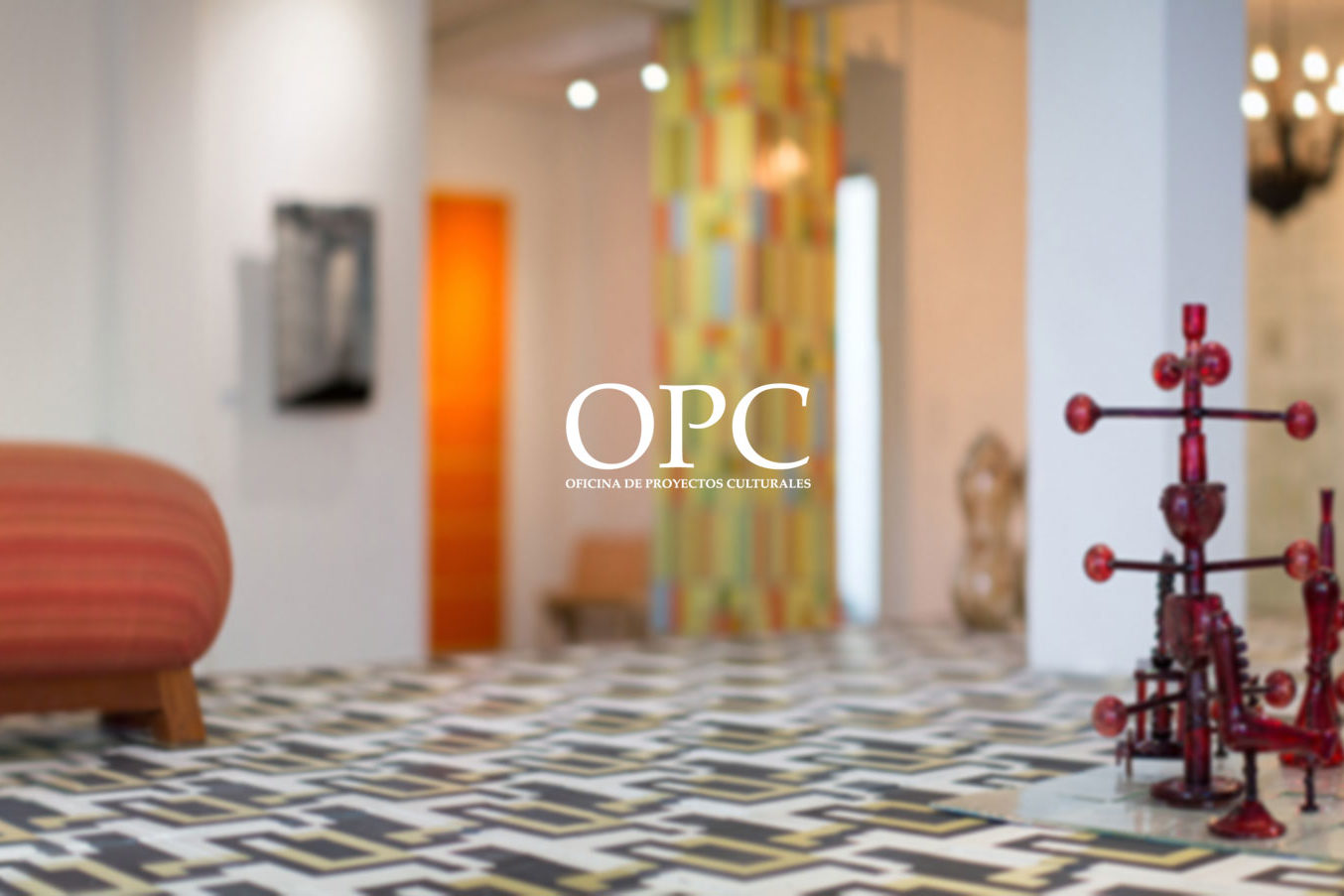
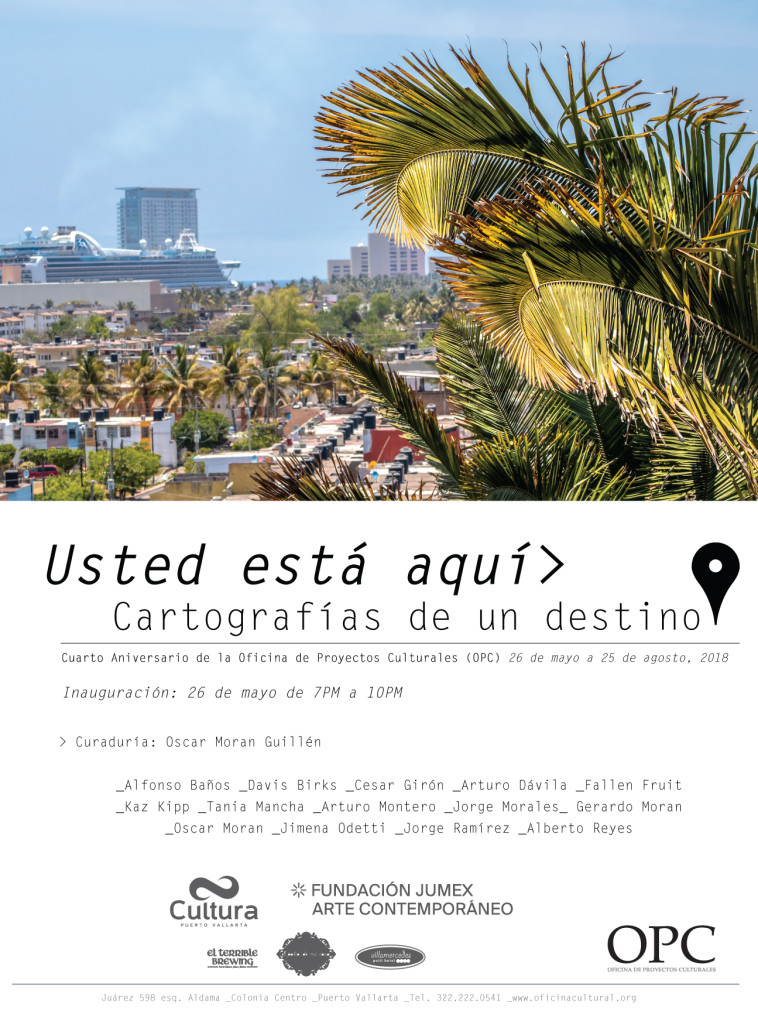 Usted está aquí: Cartografías de un destino
Usted está aquí: Cartografías de un destino